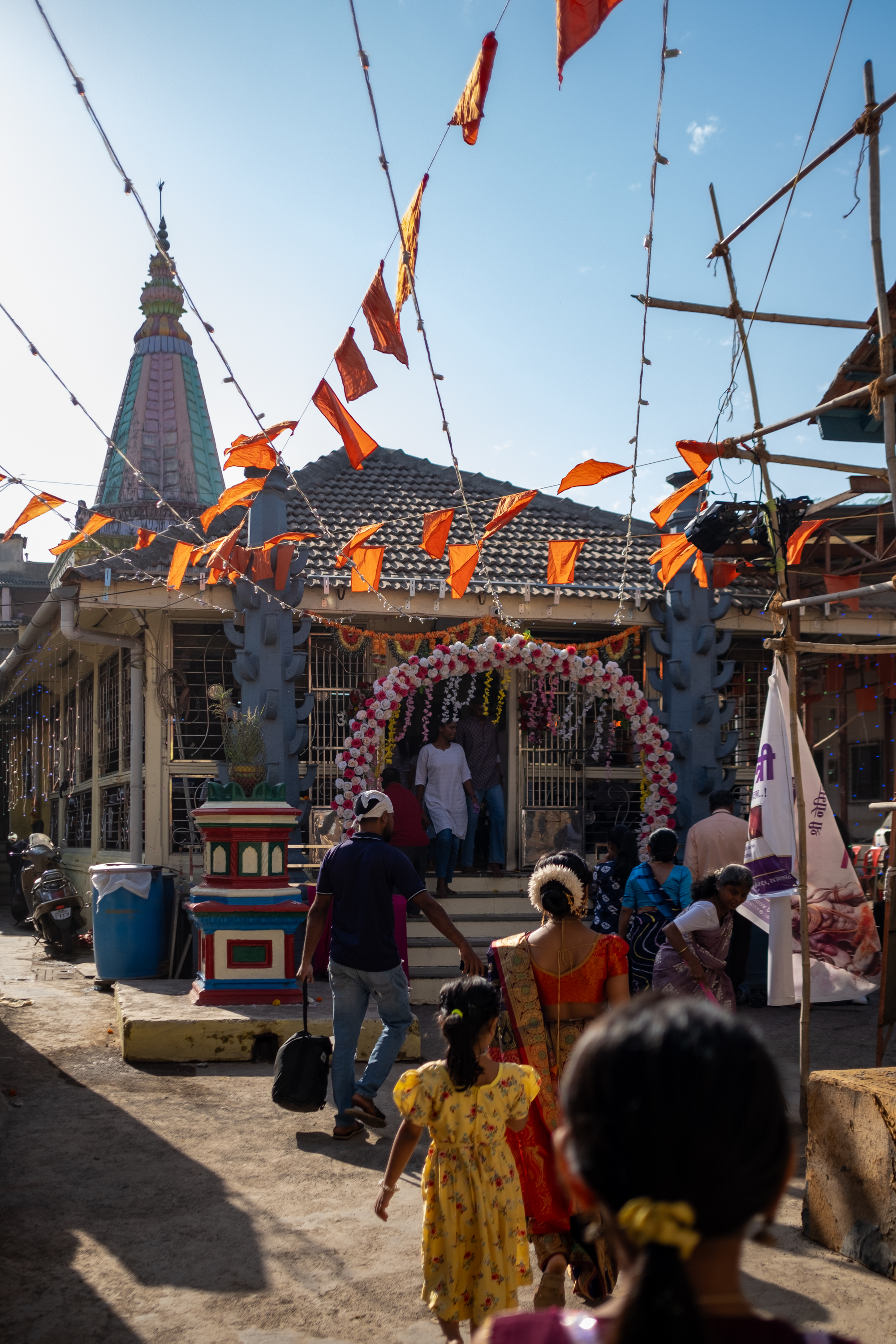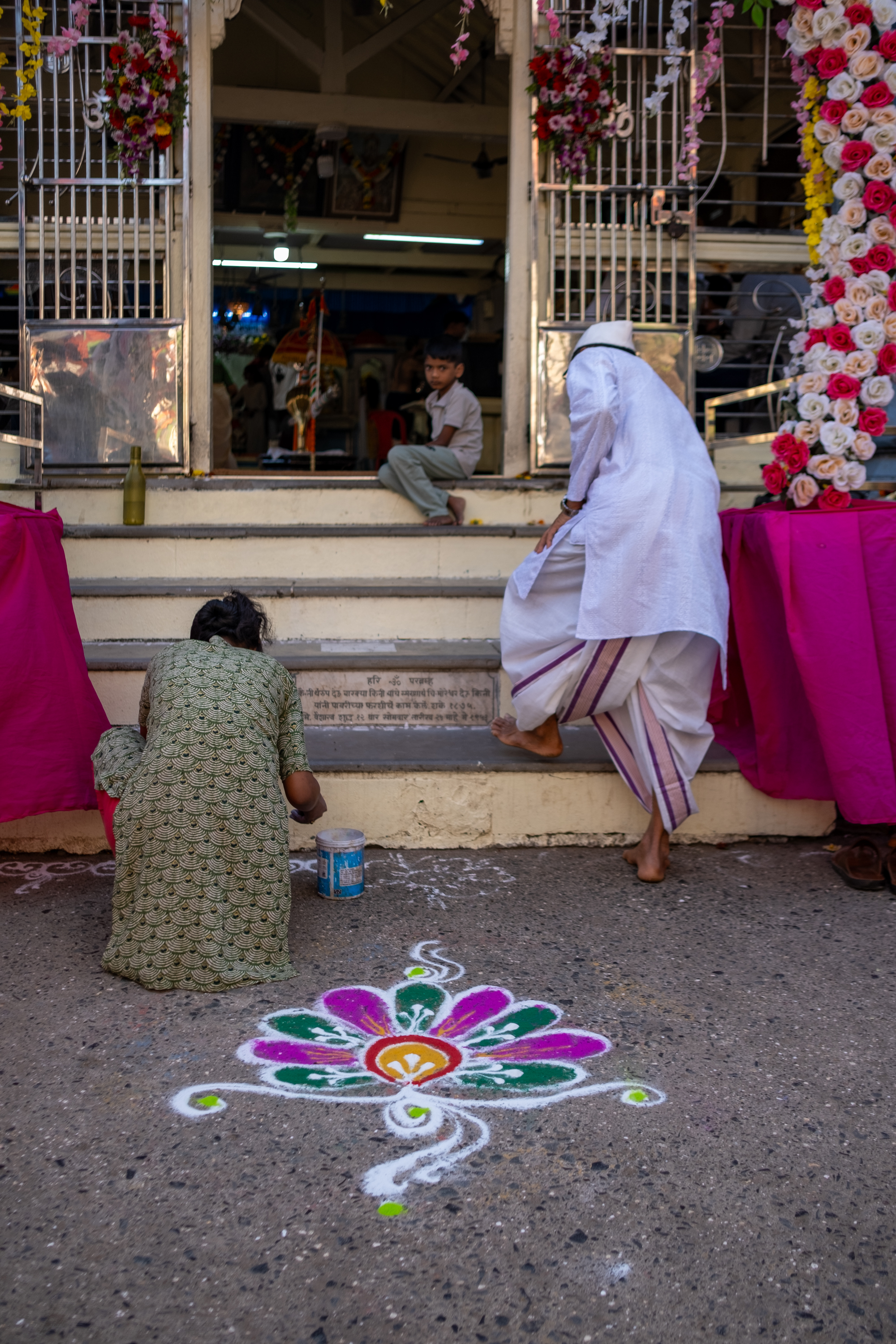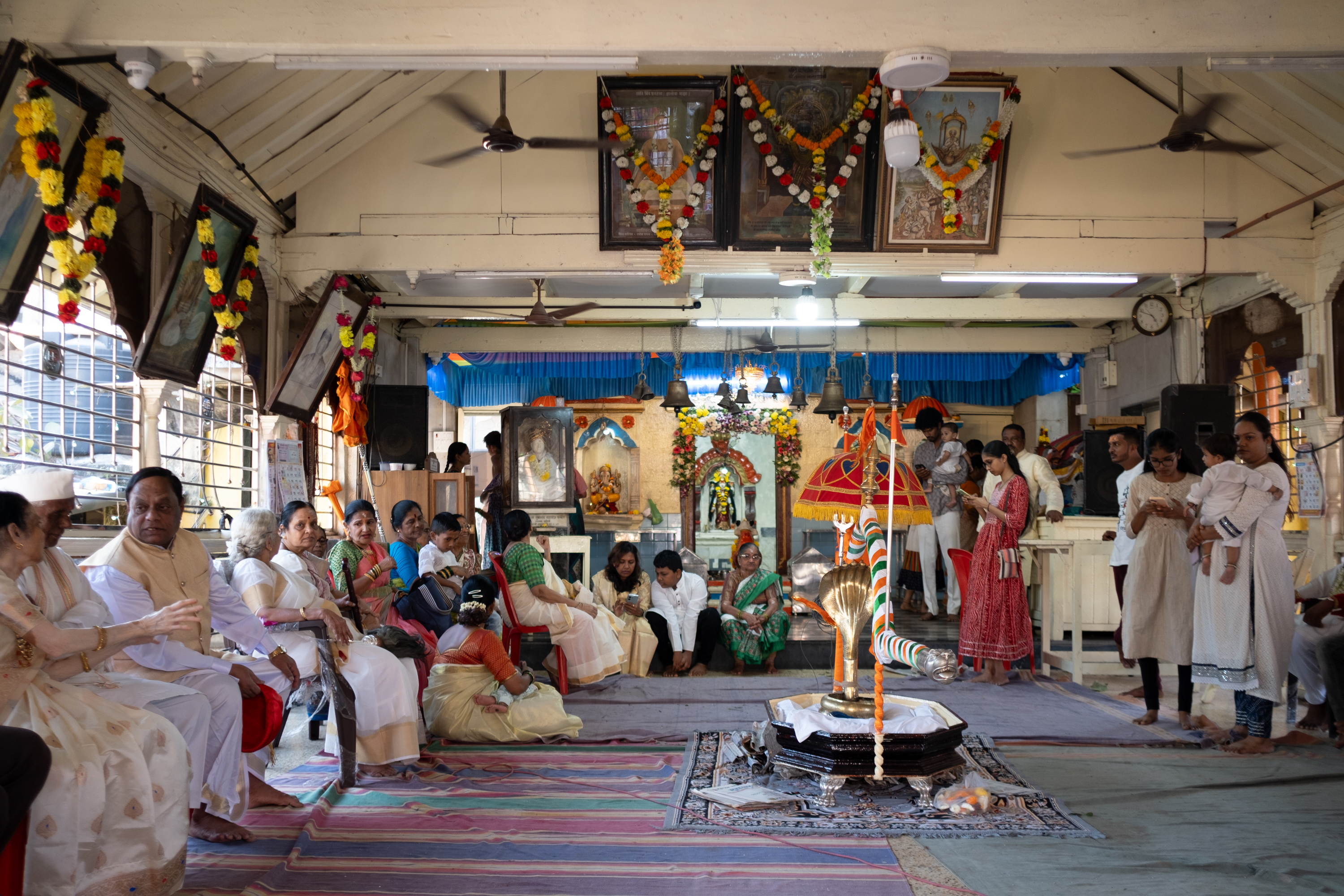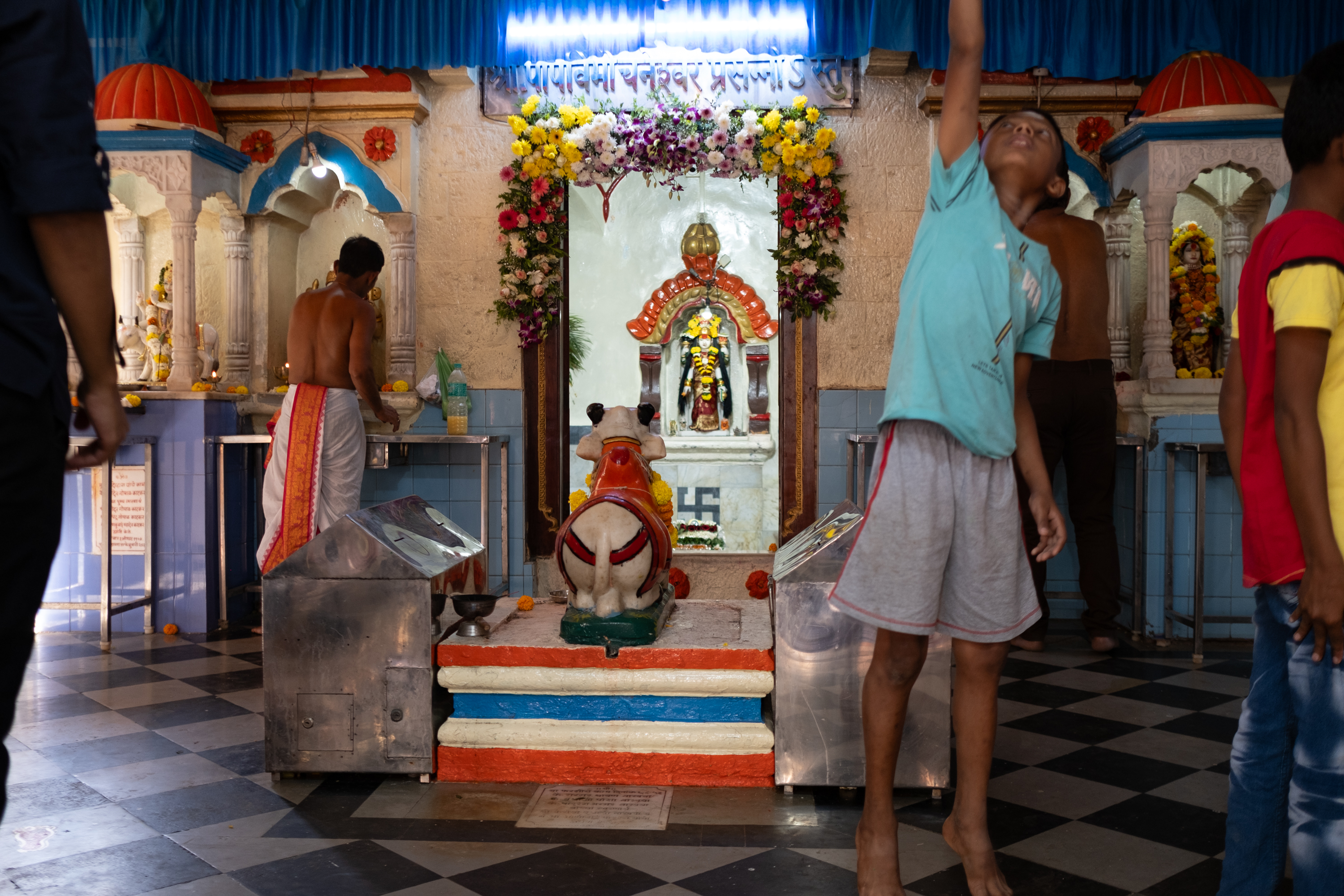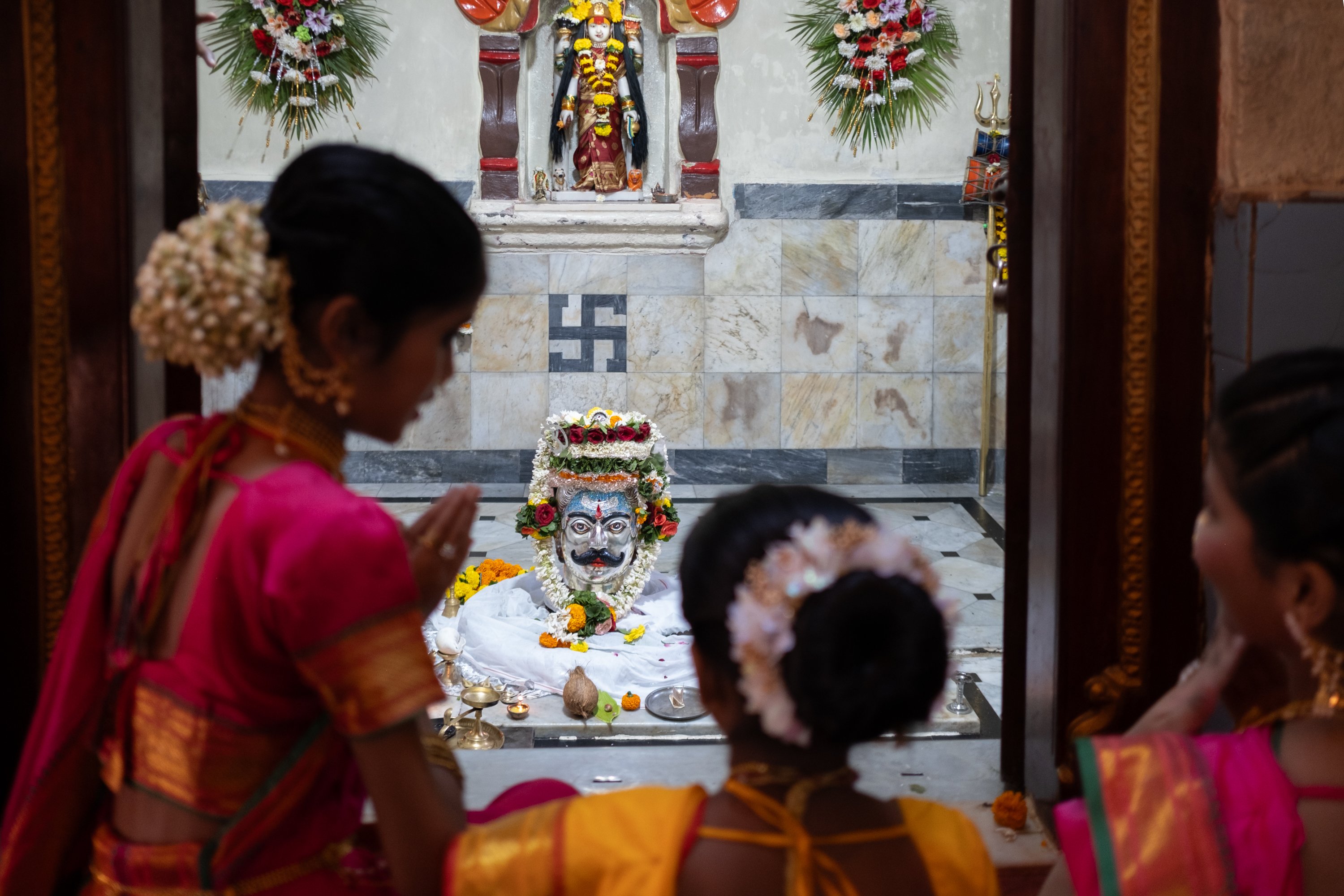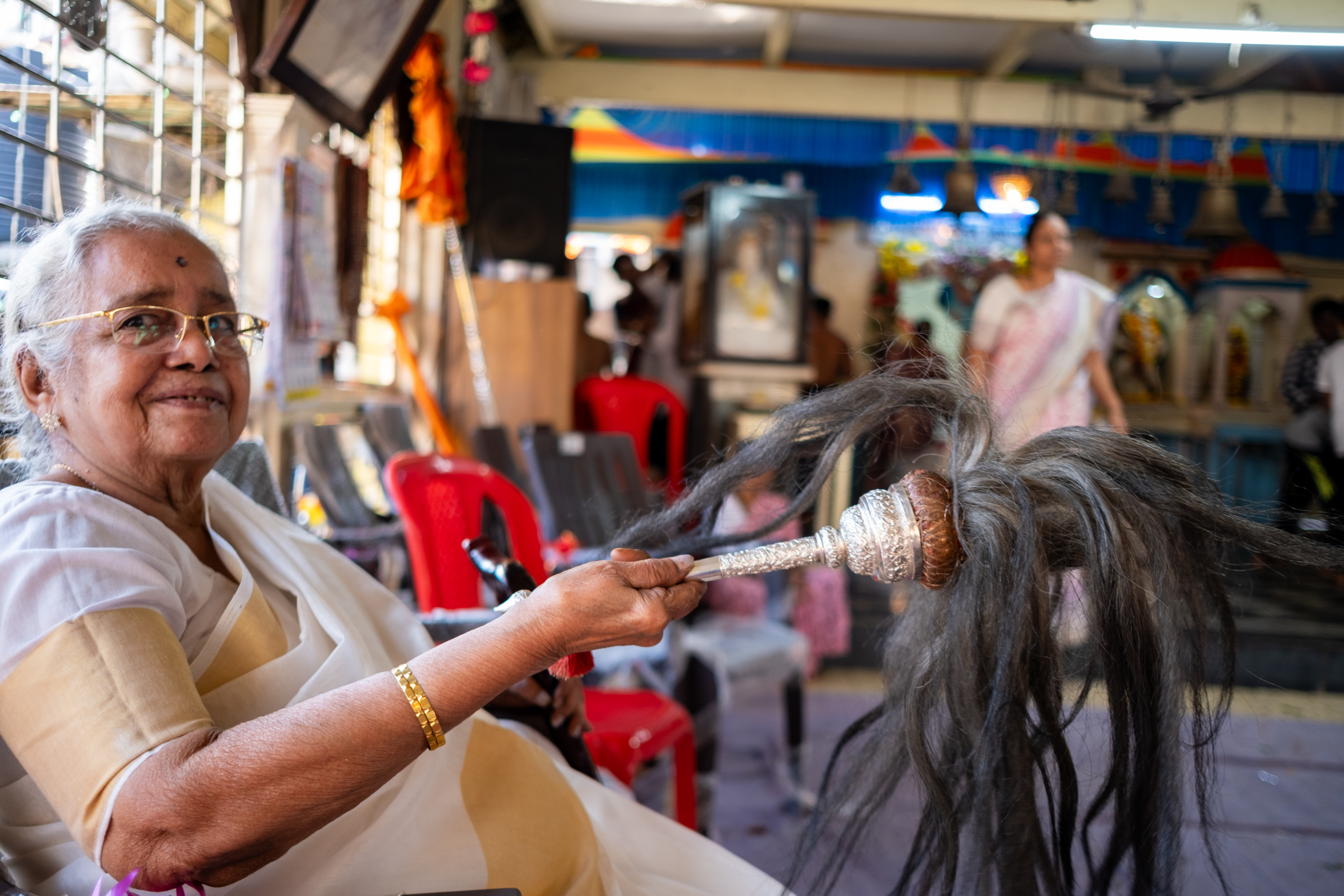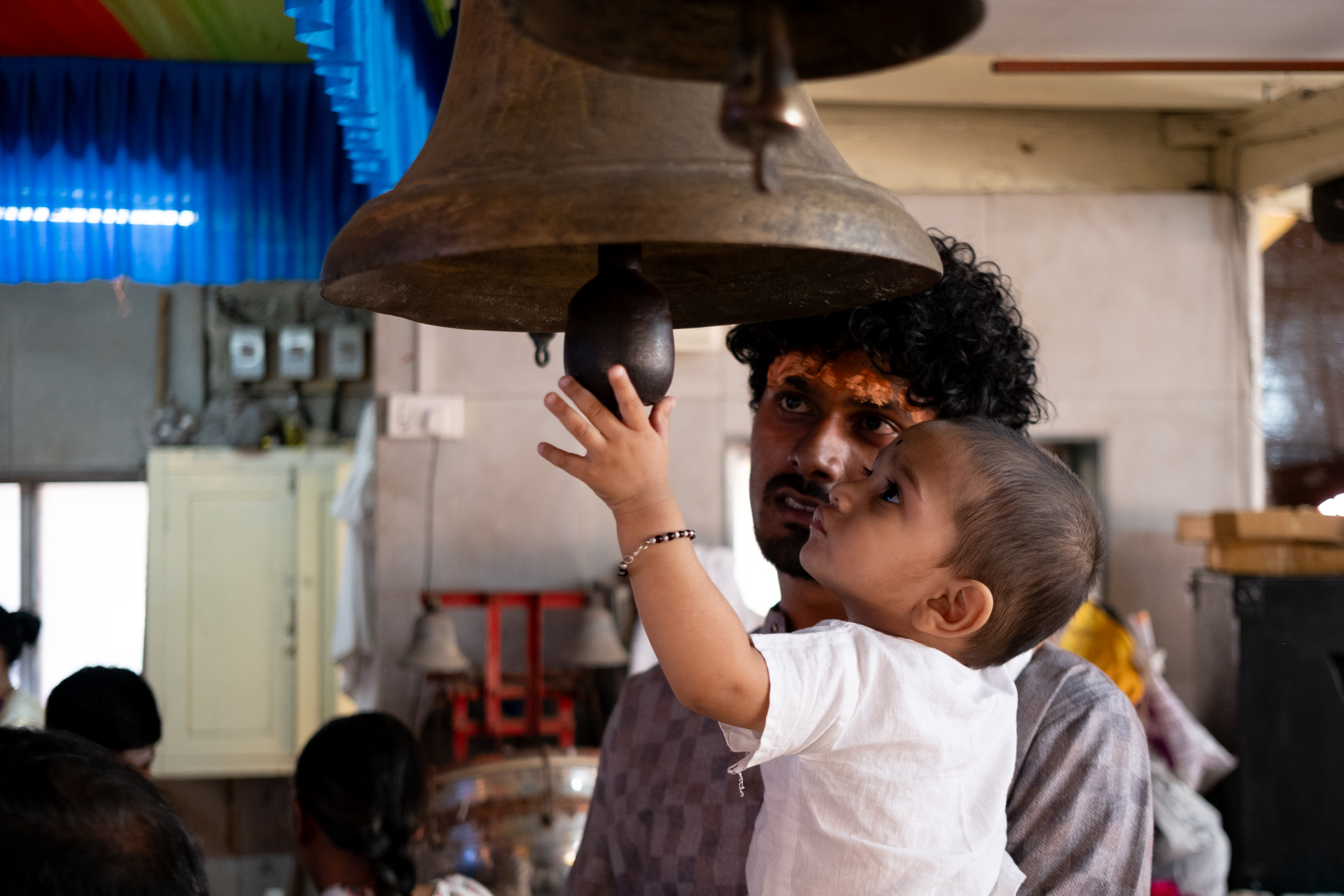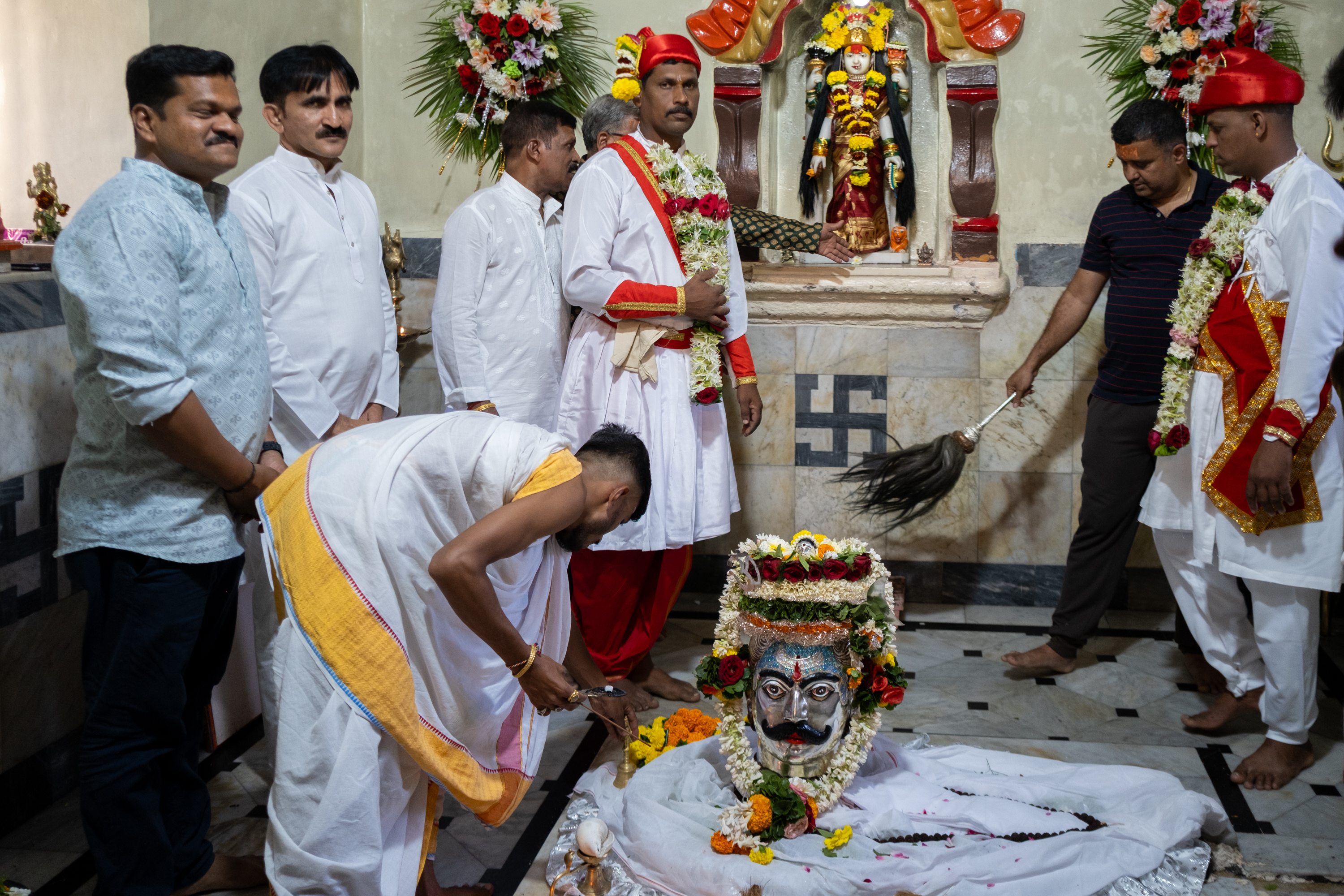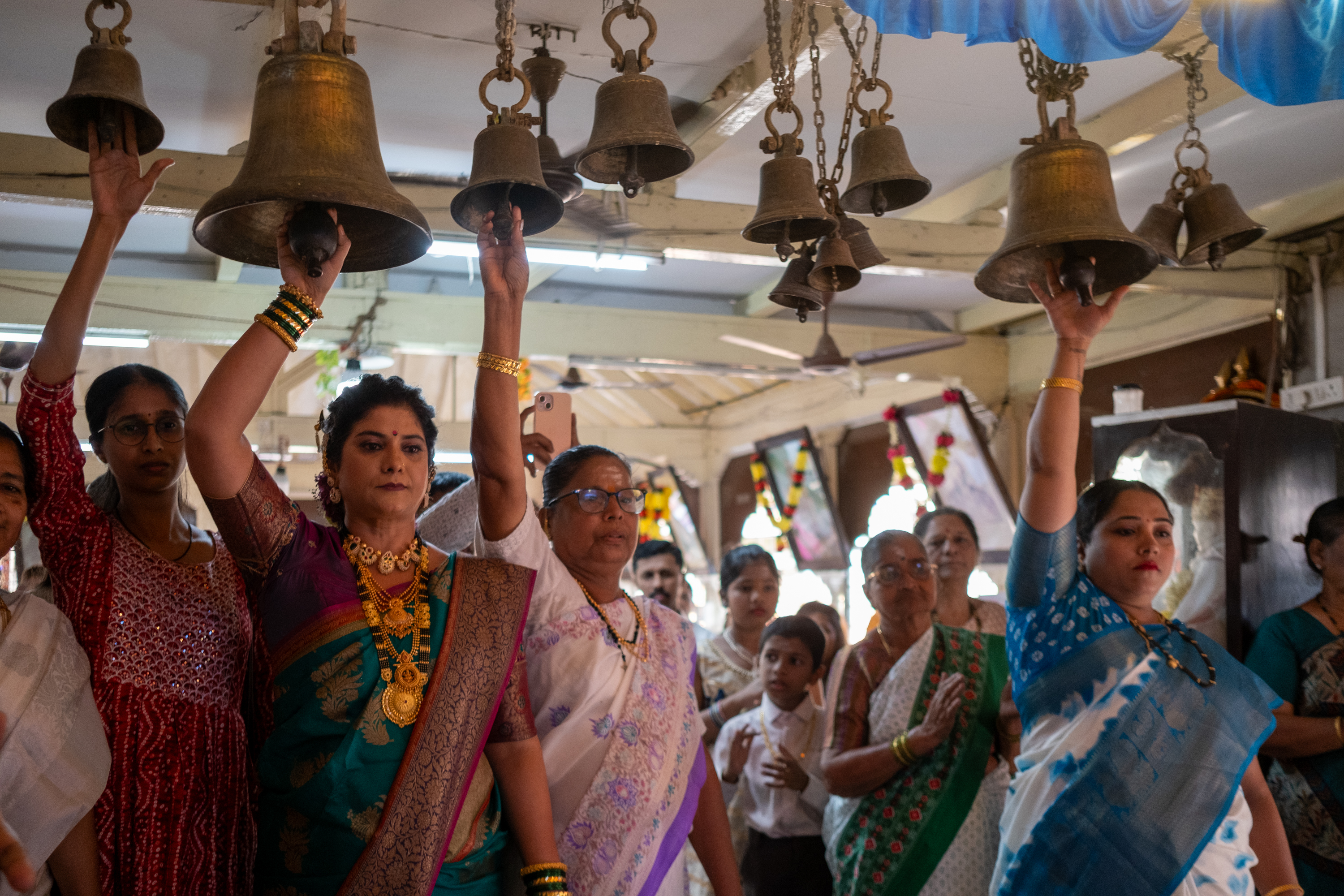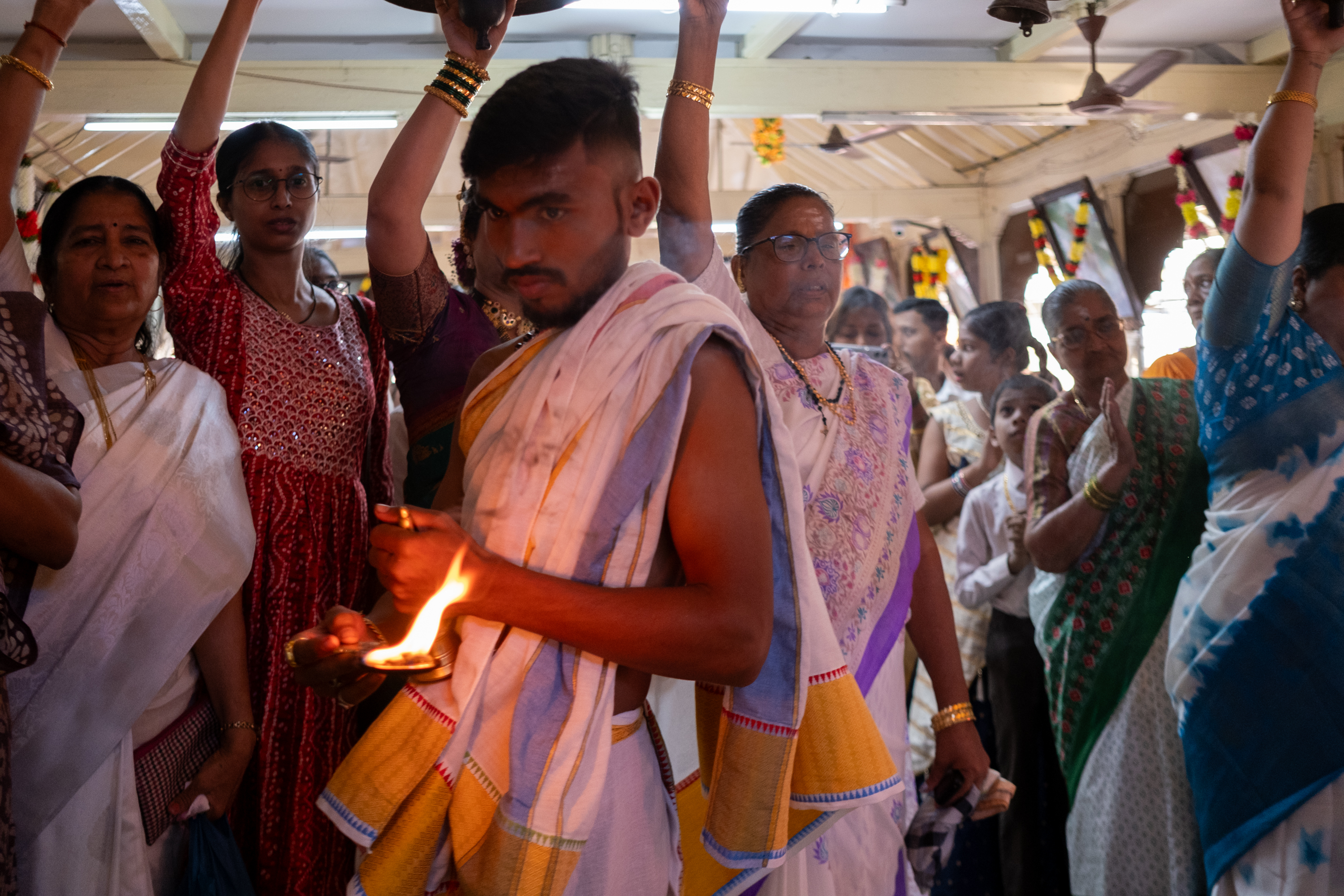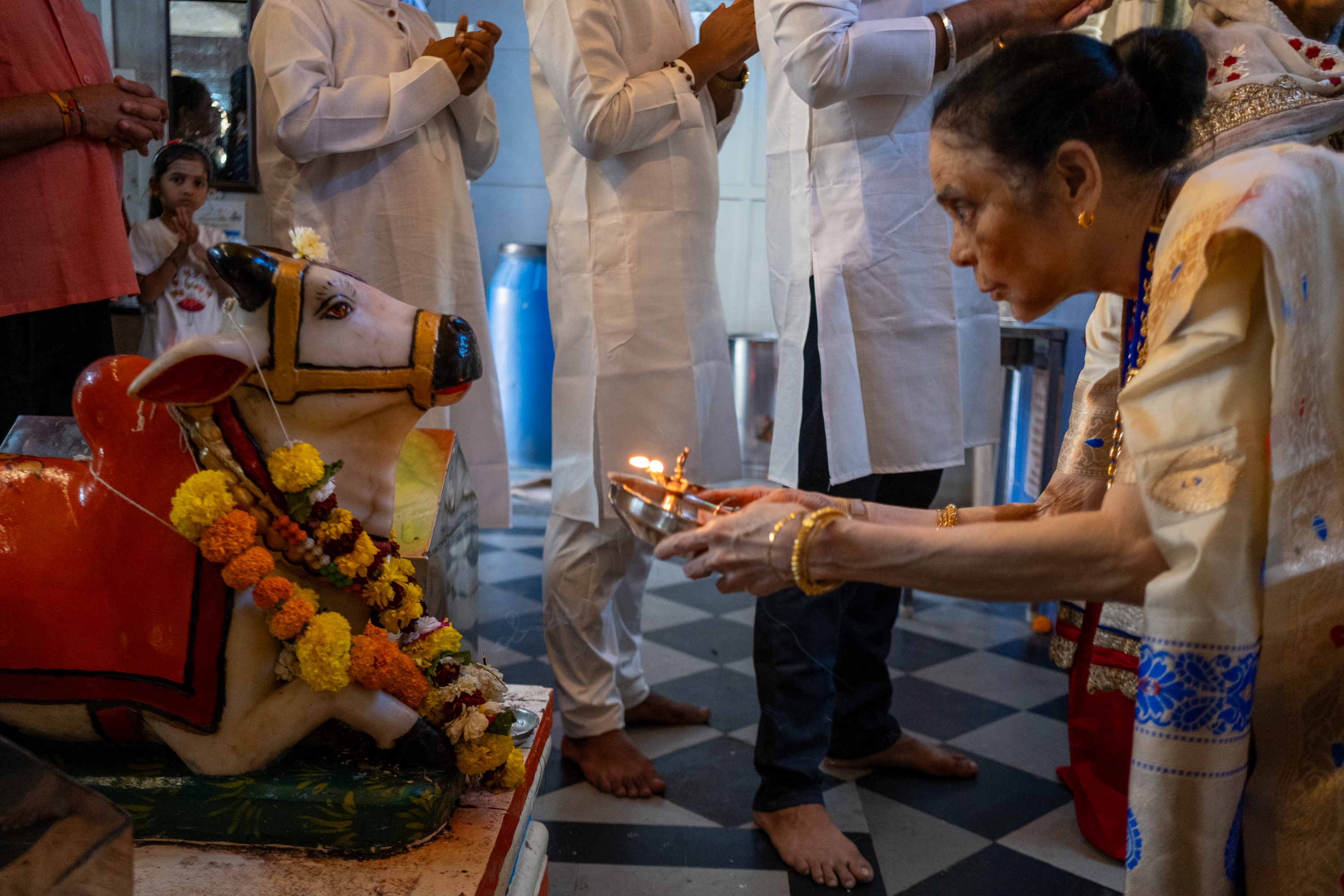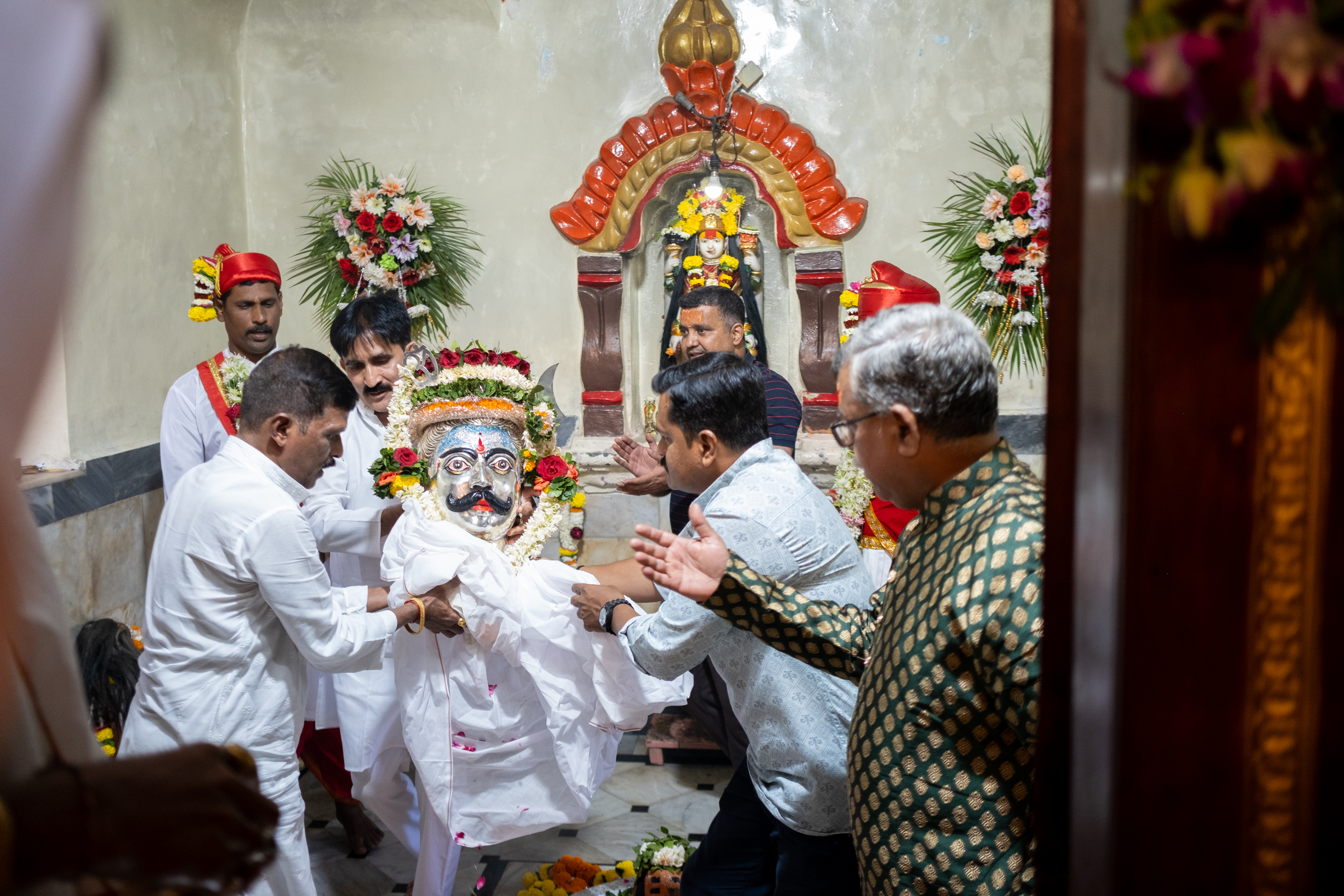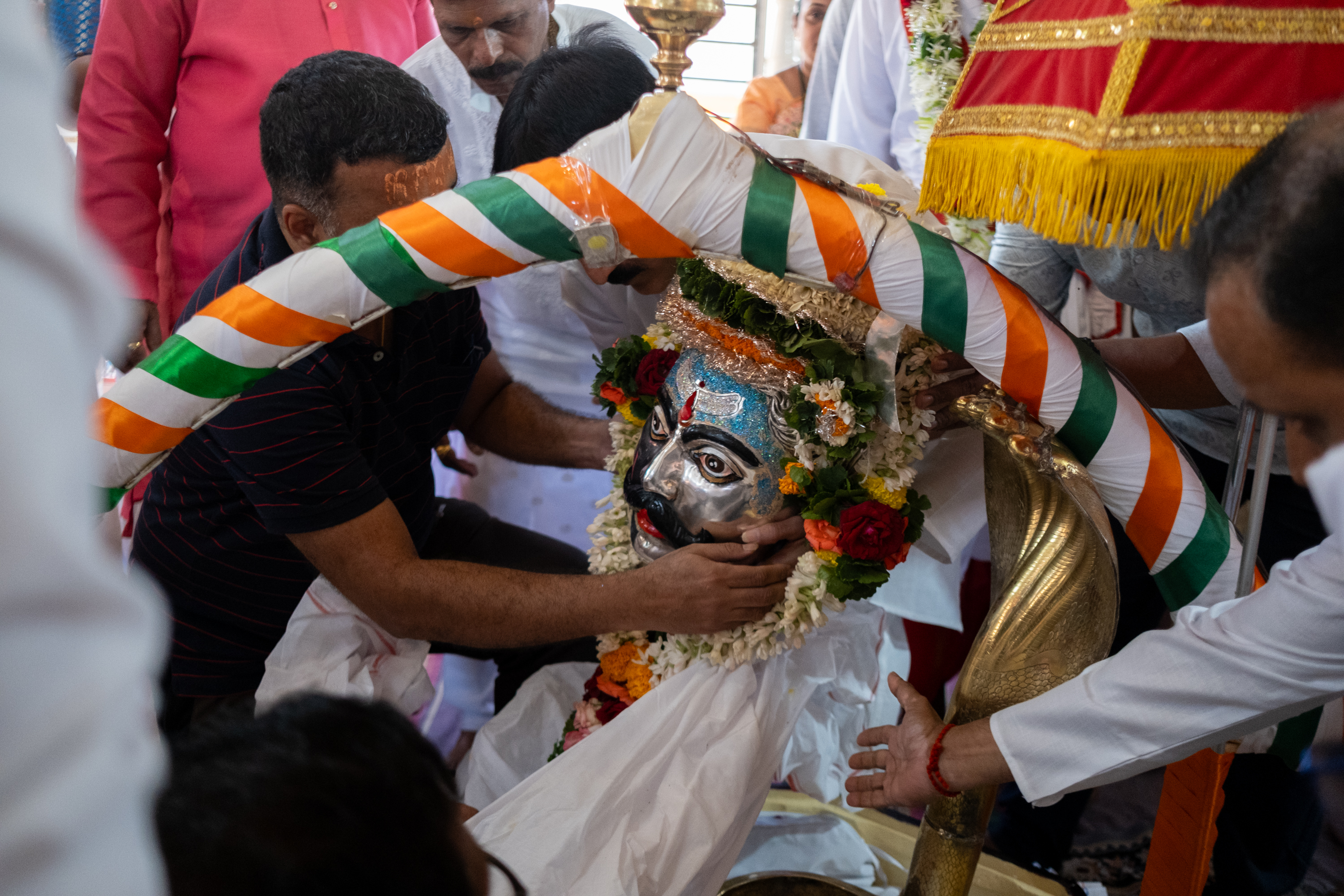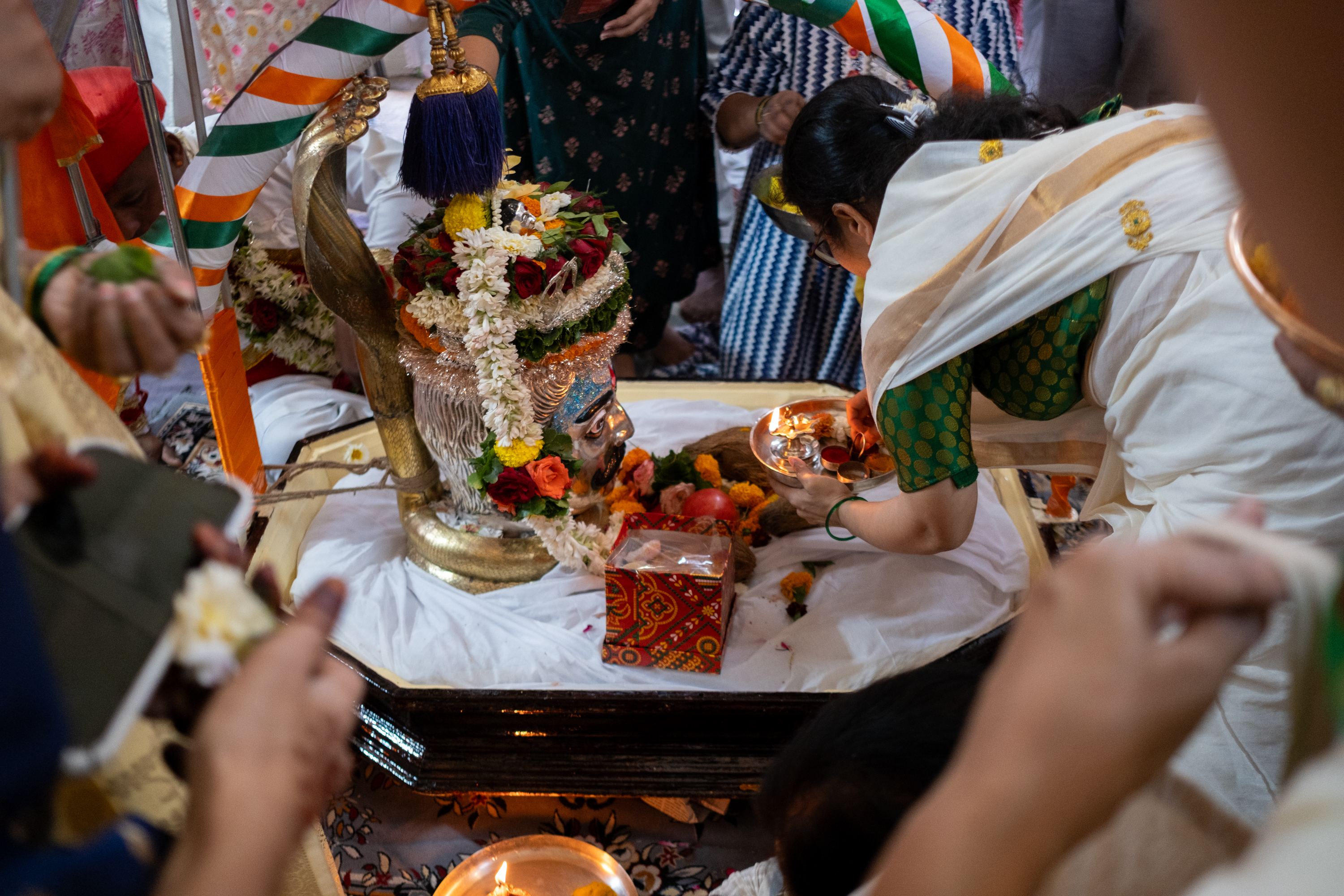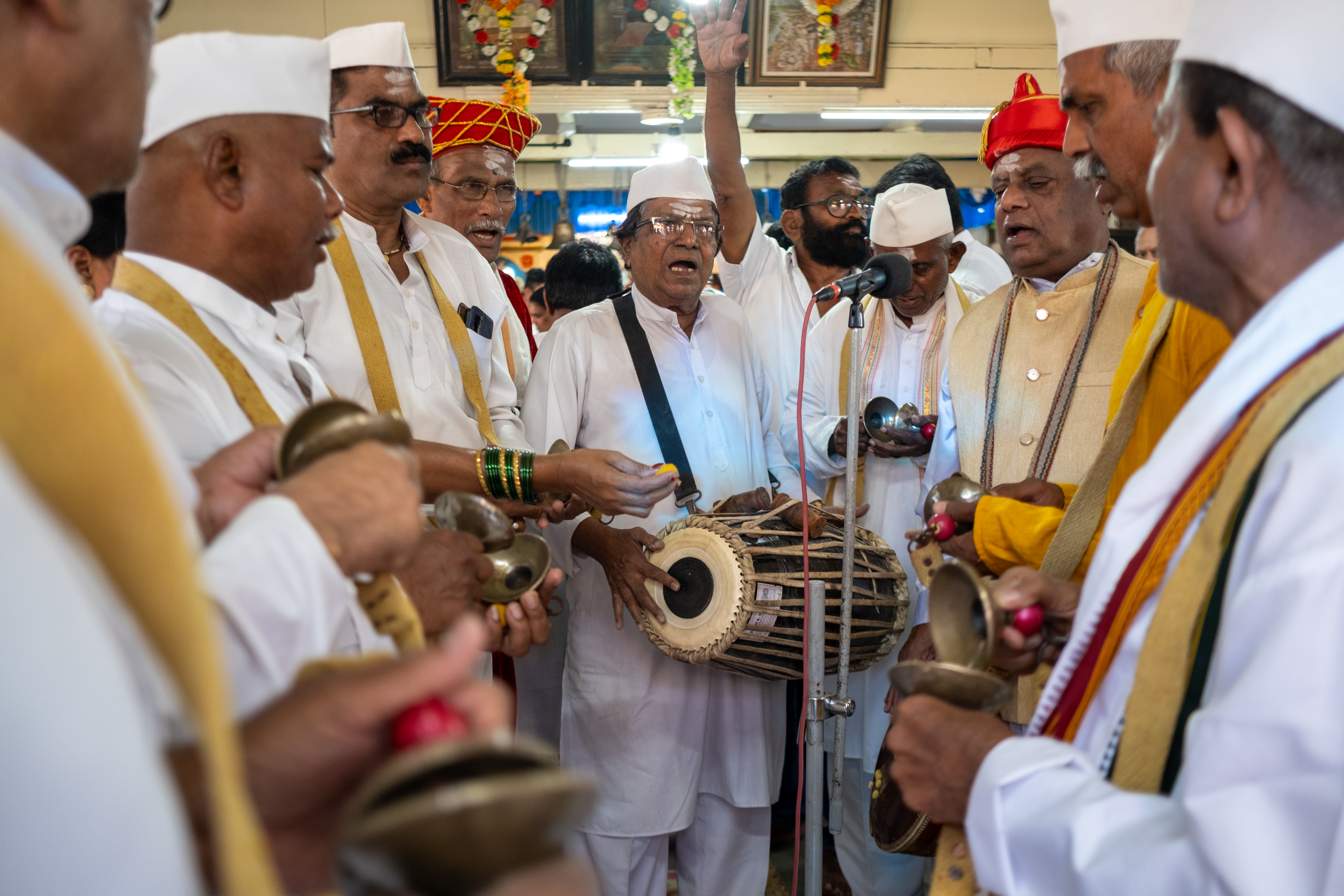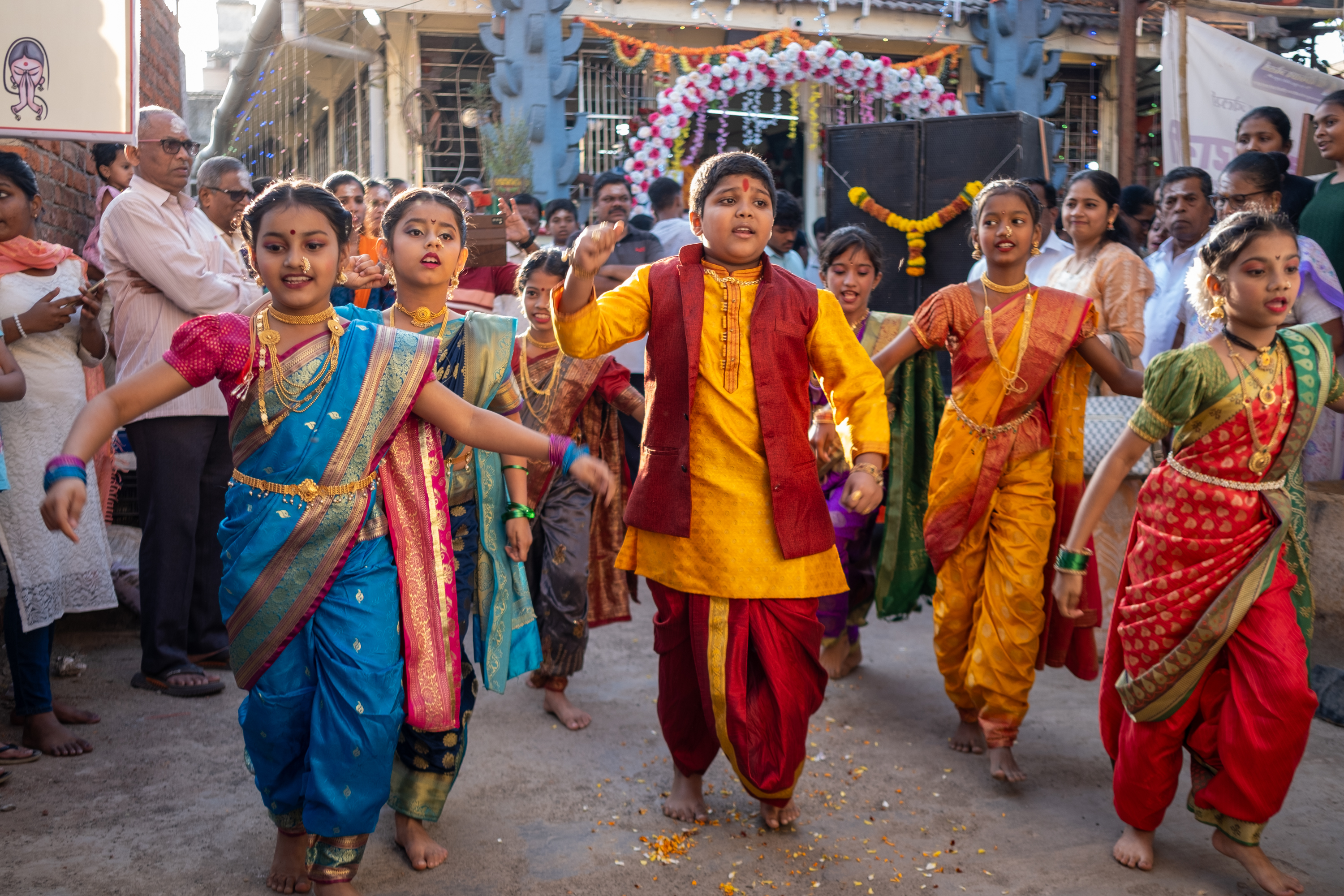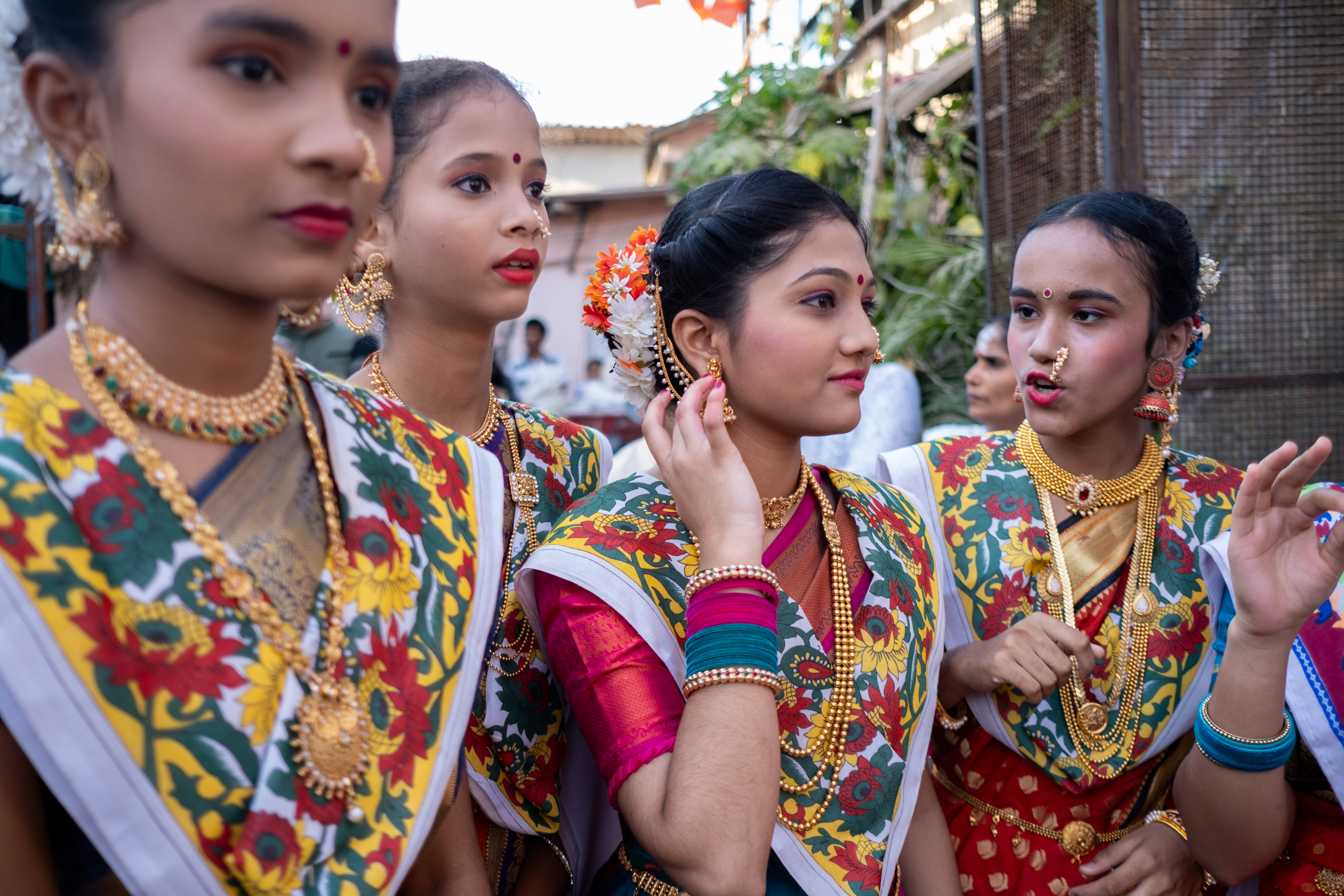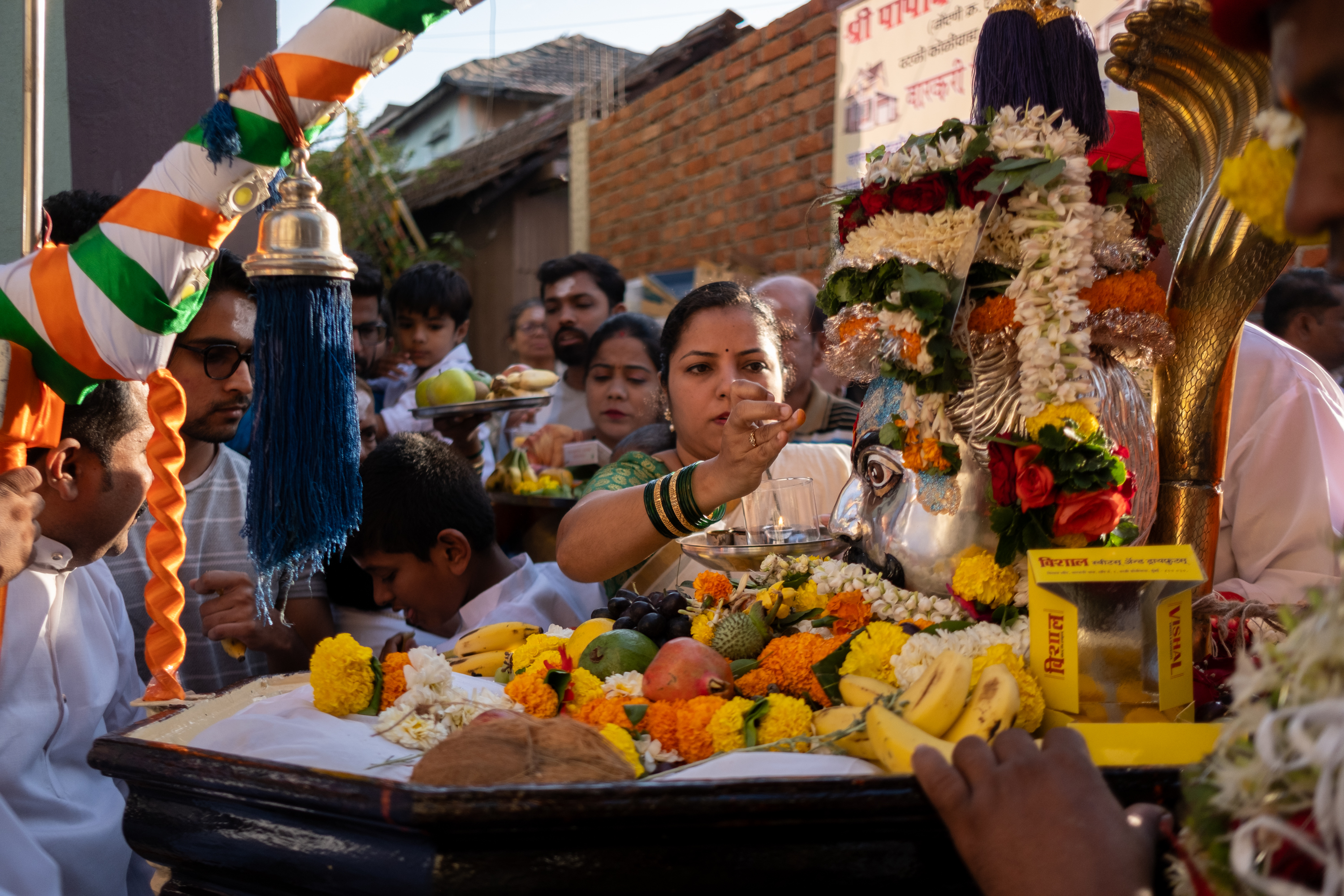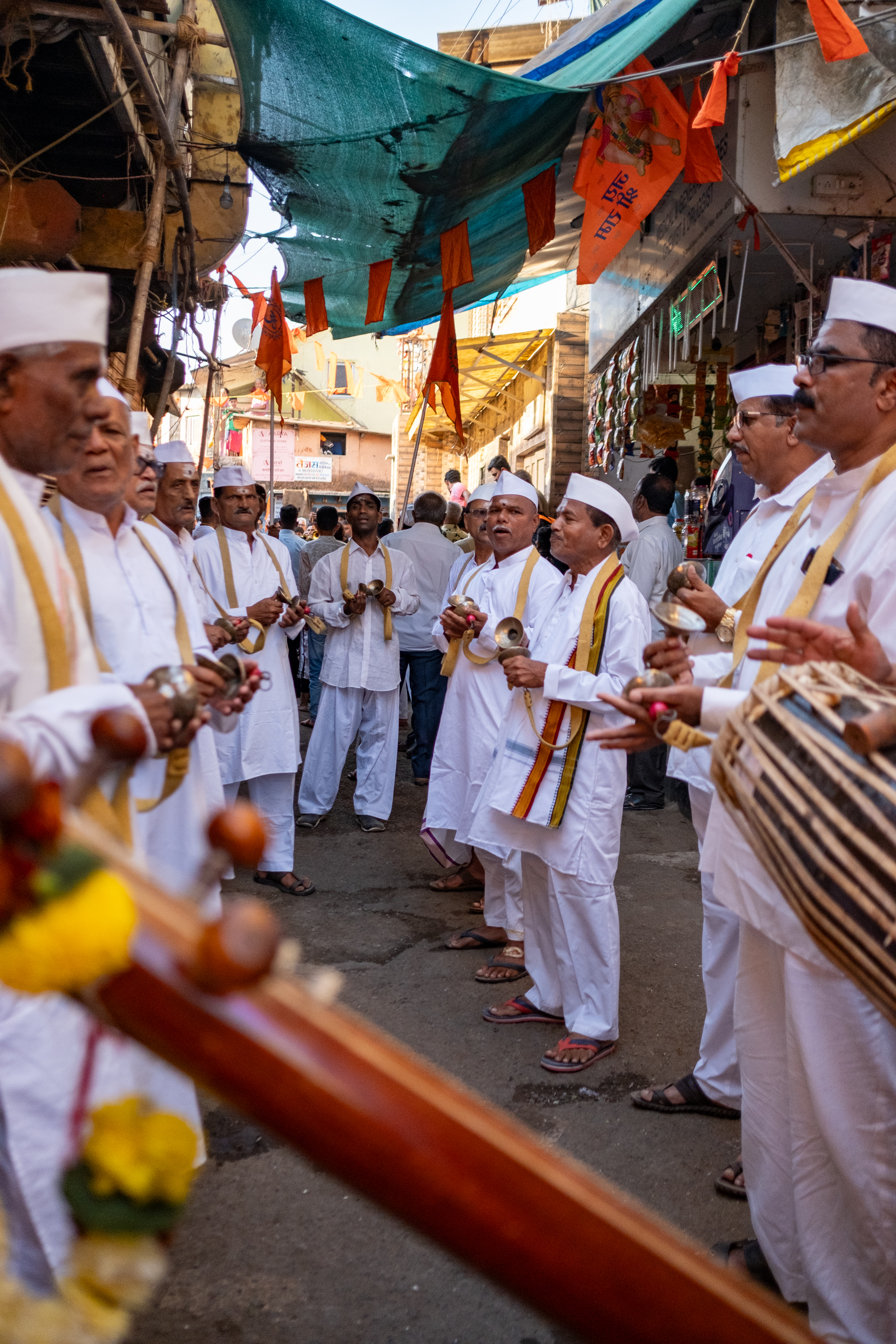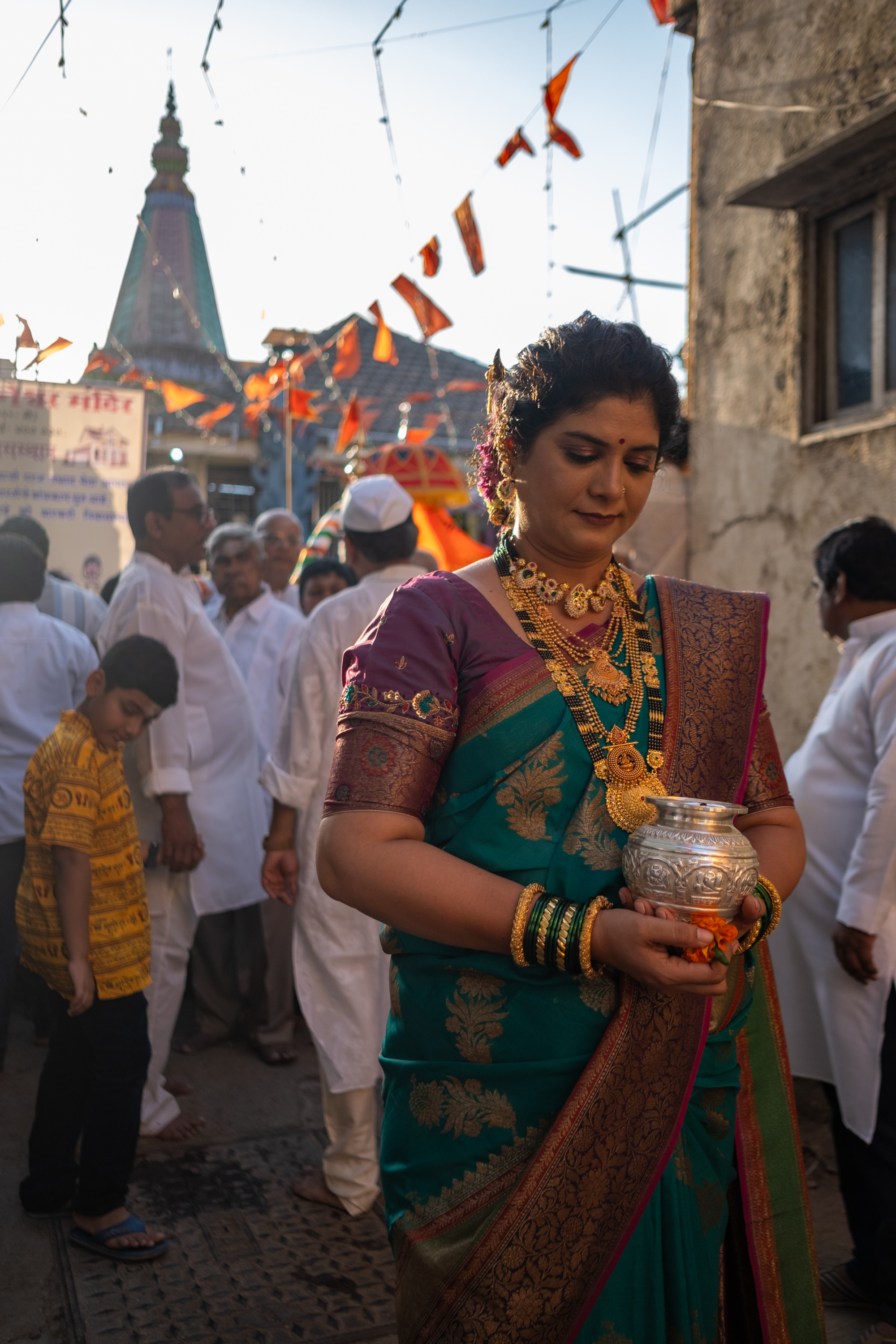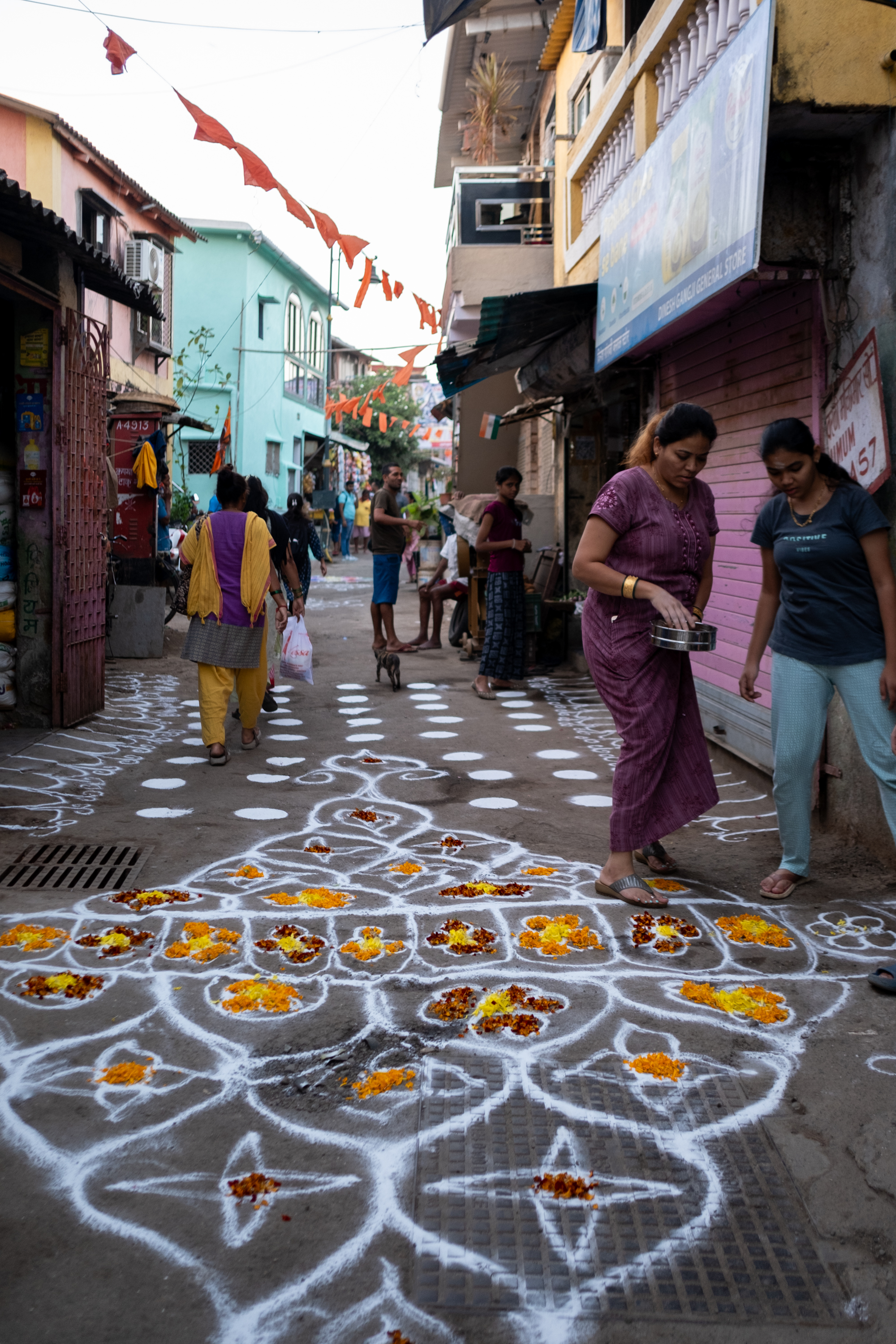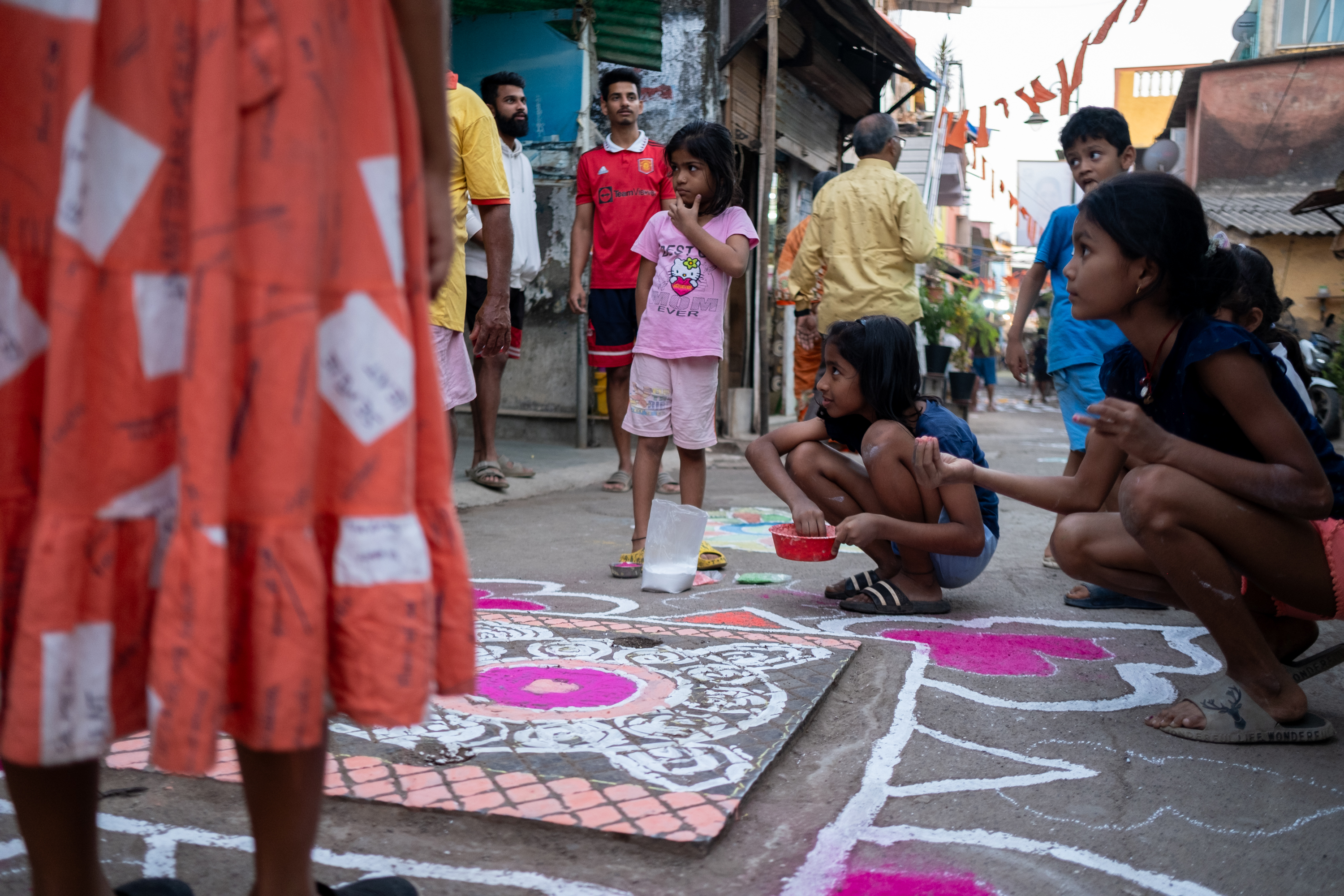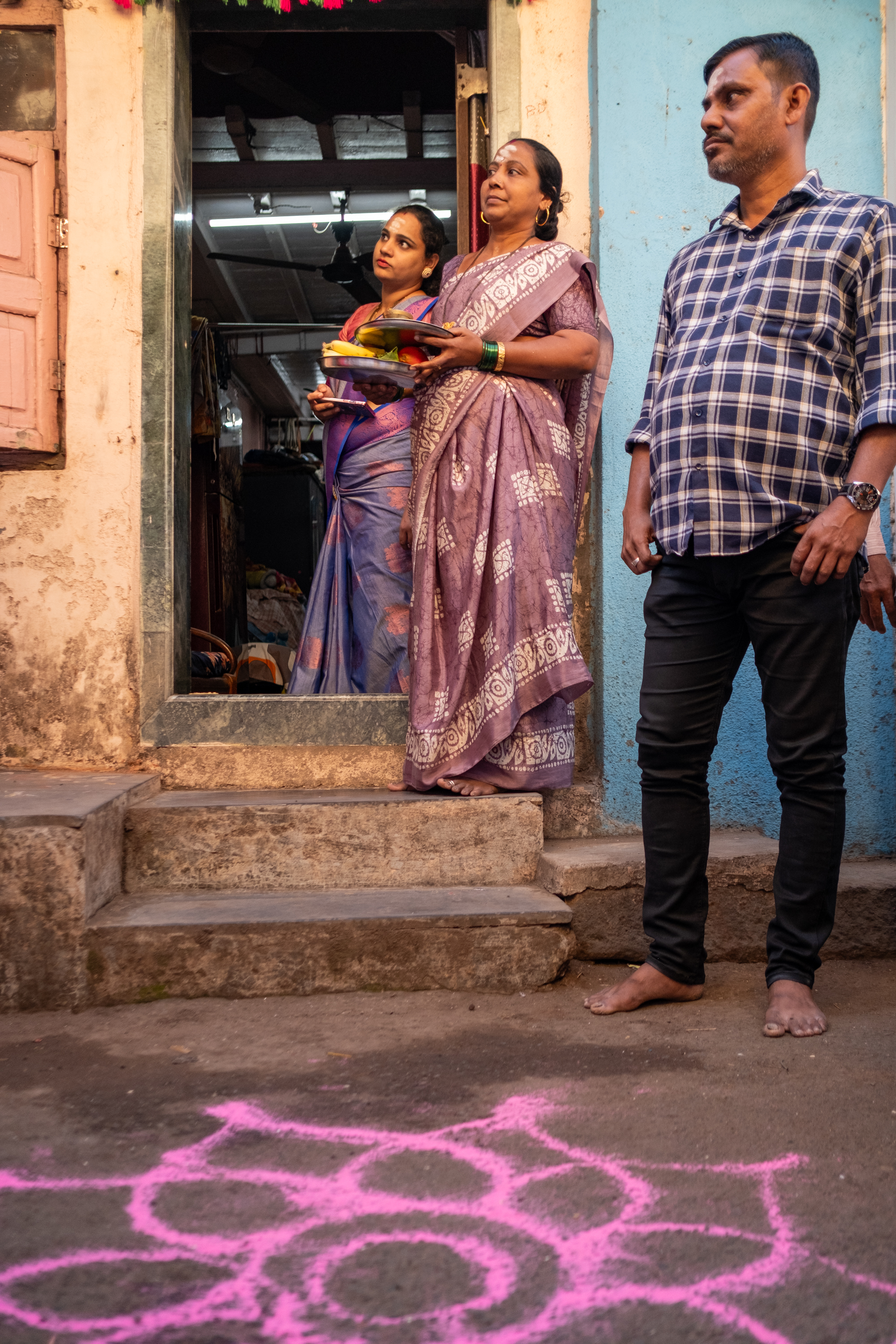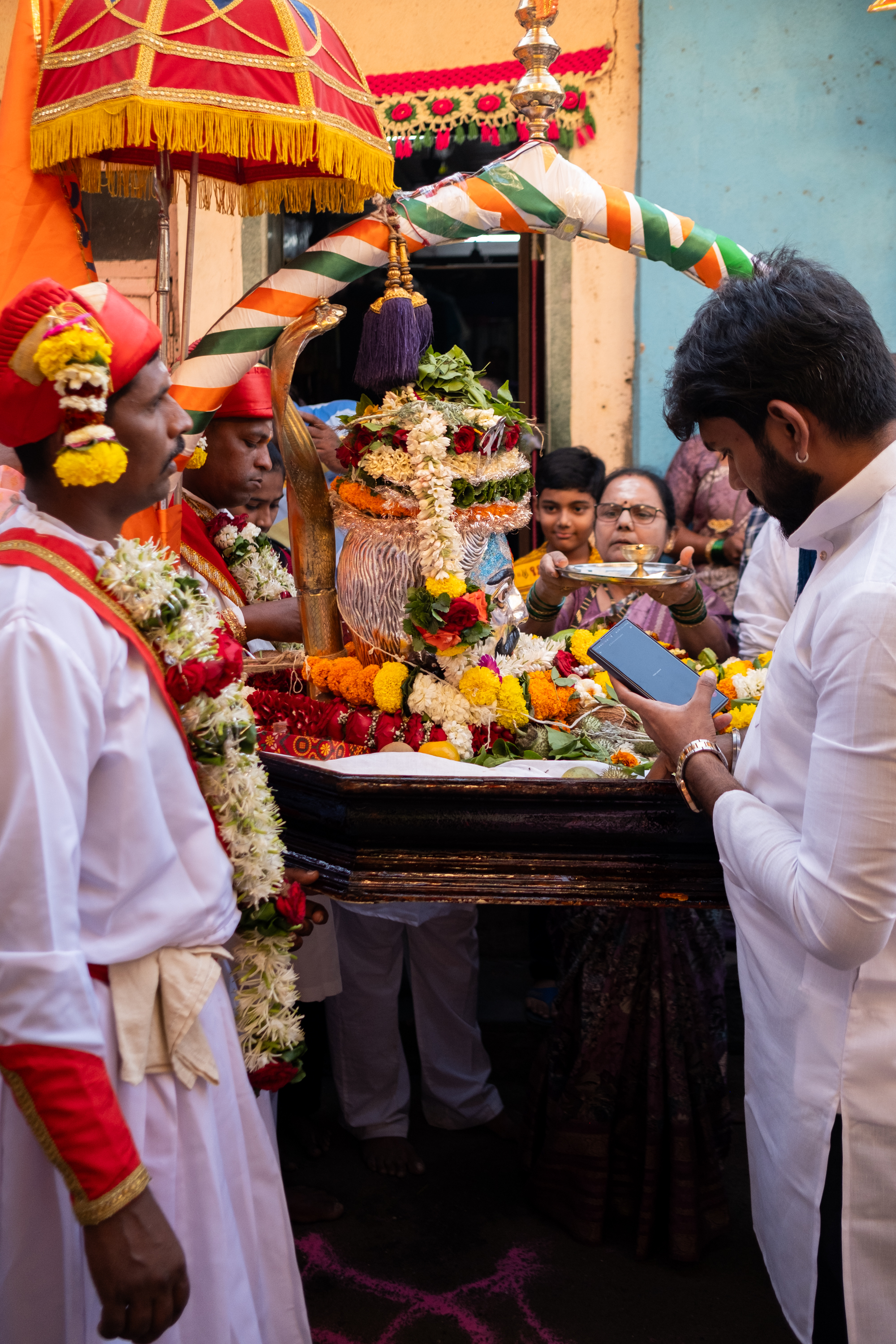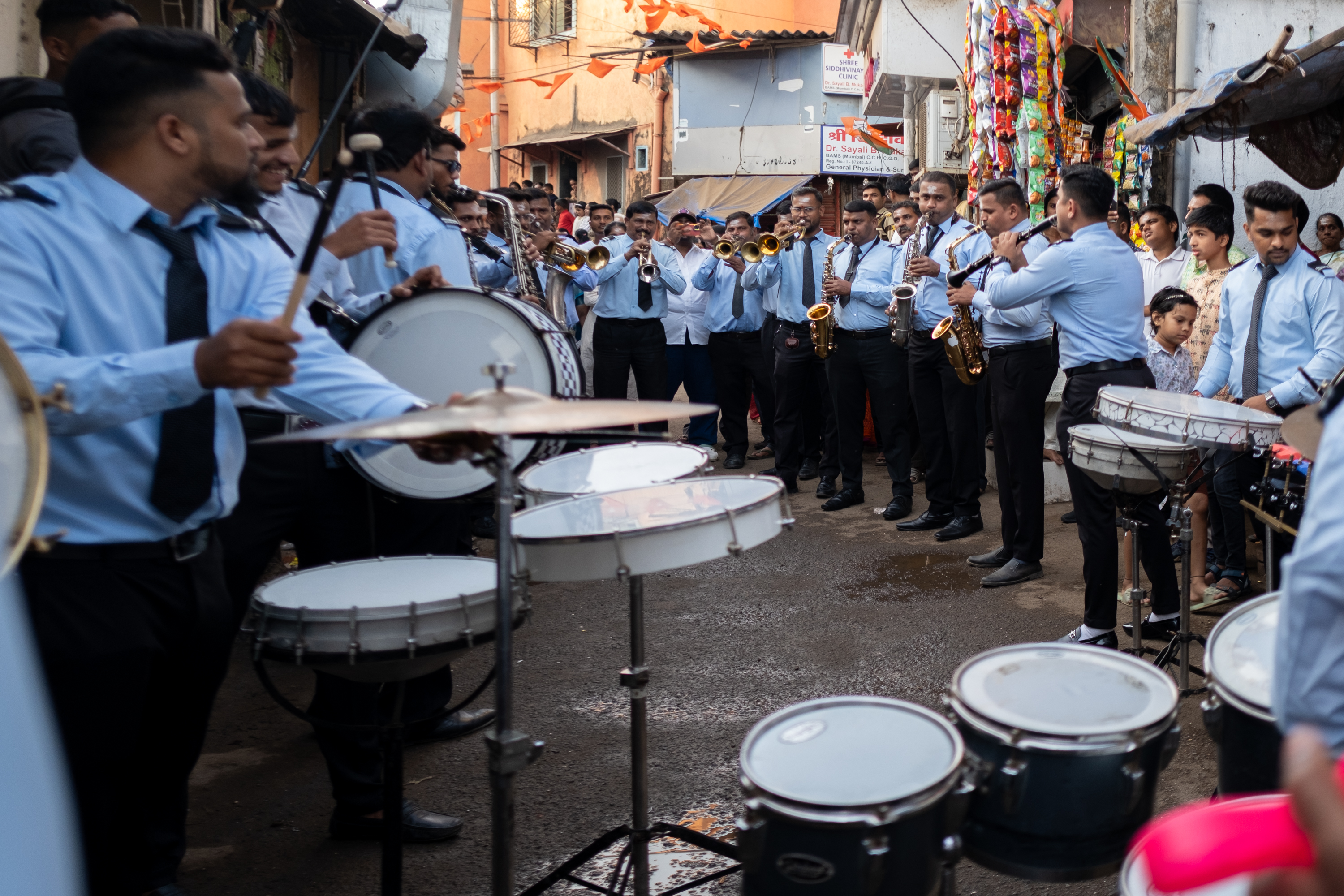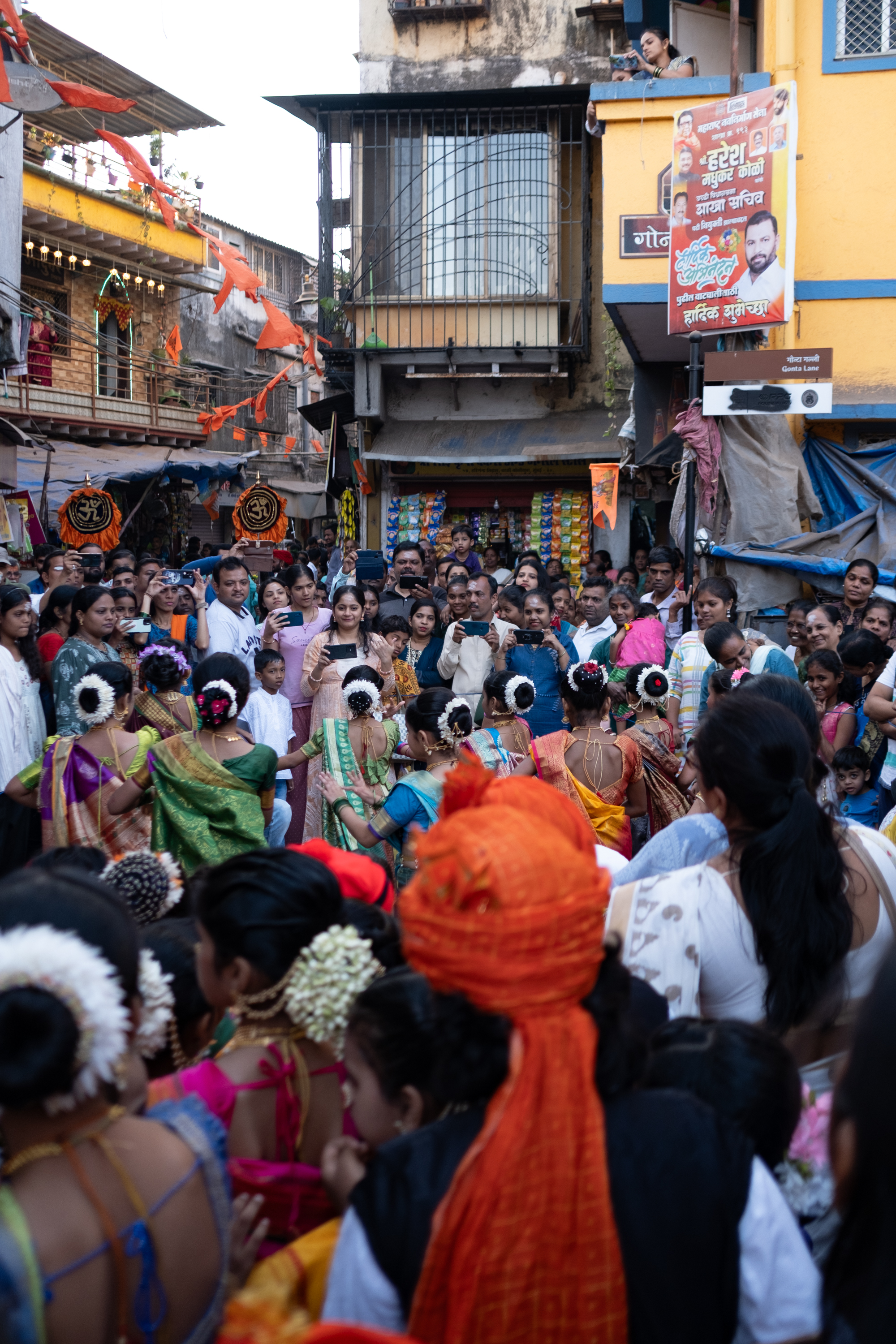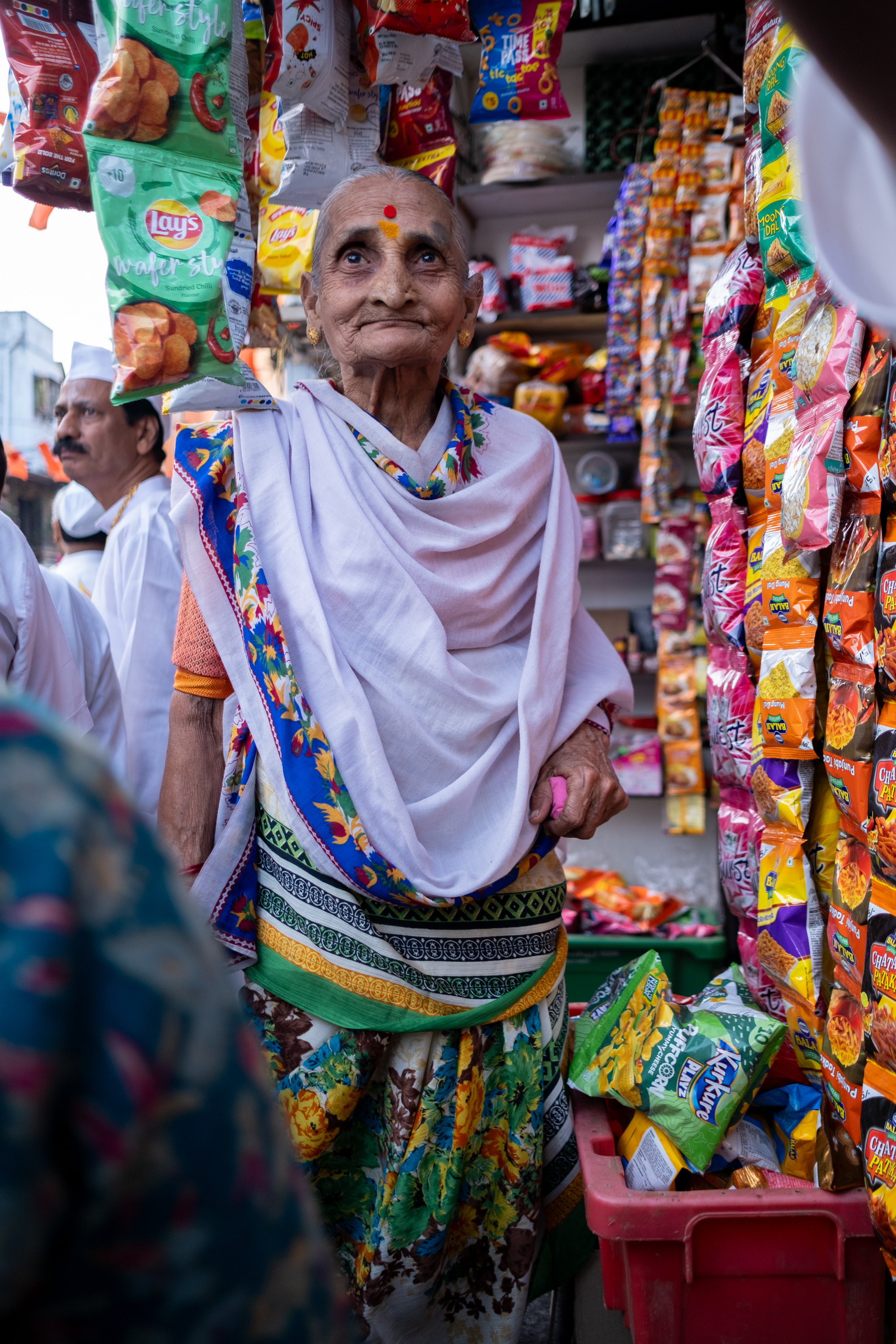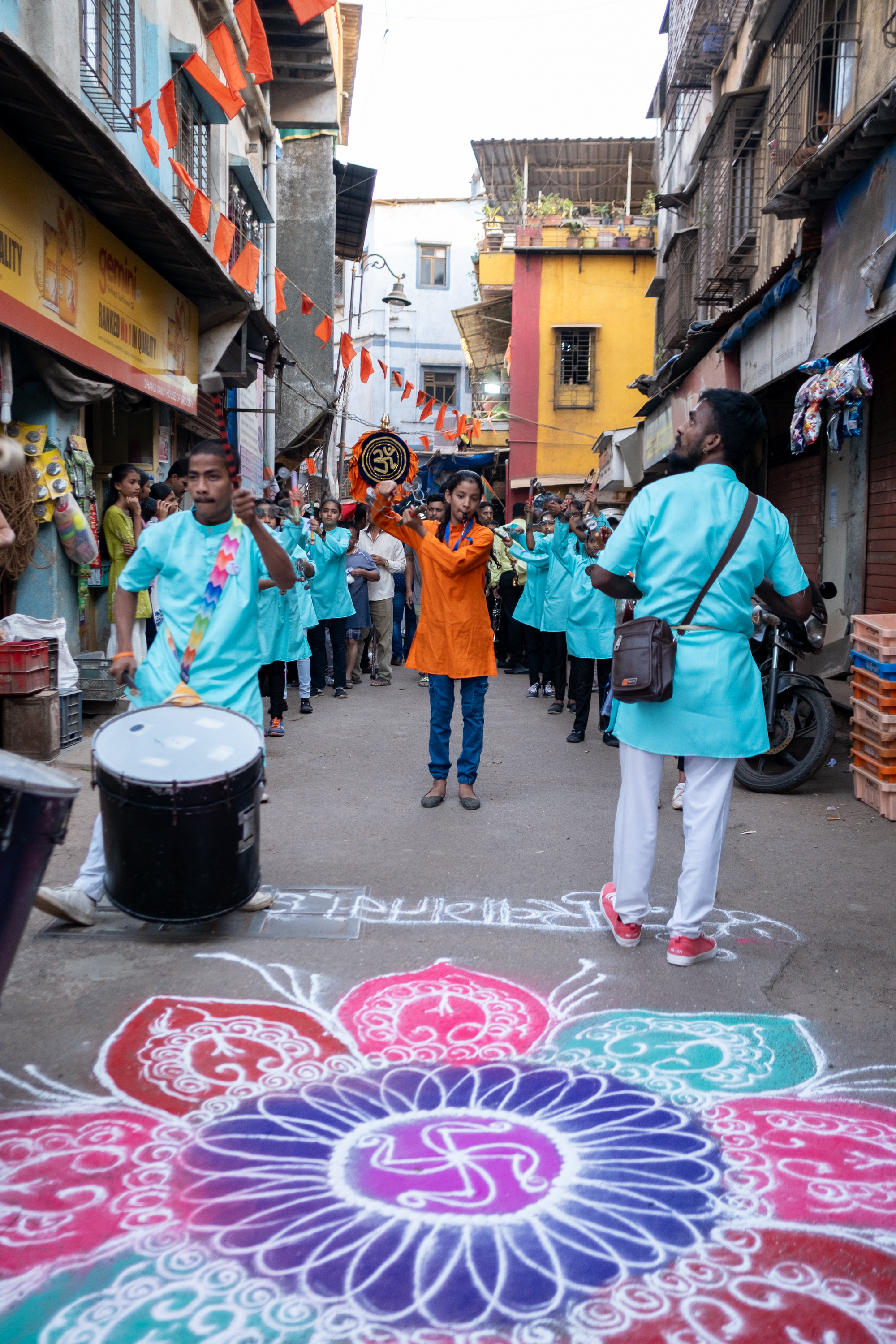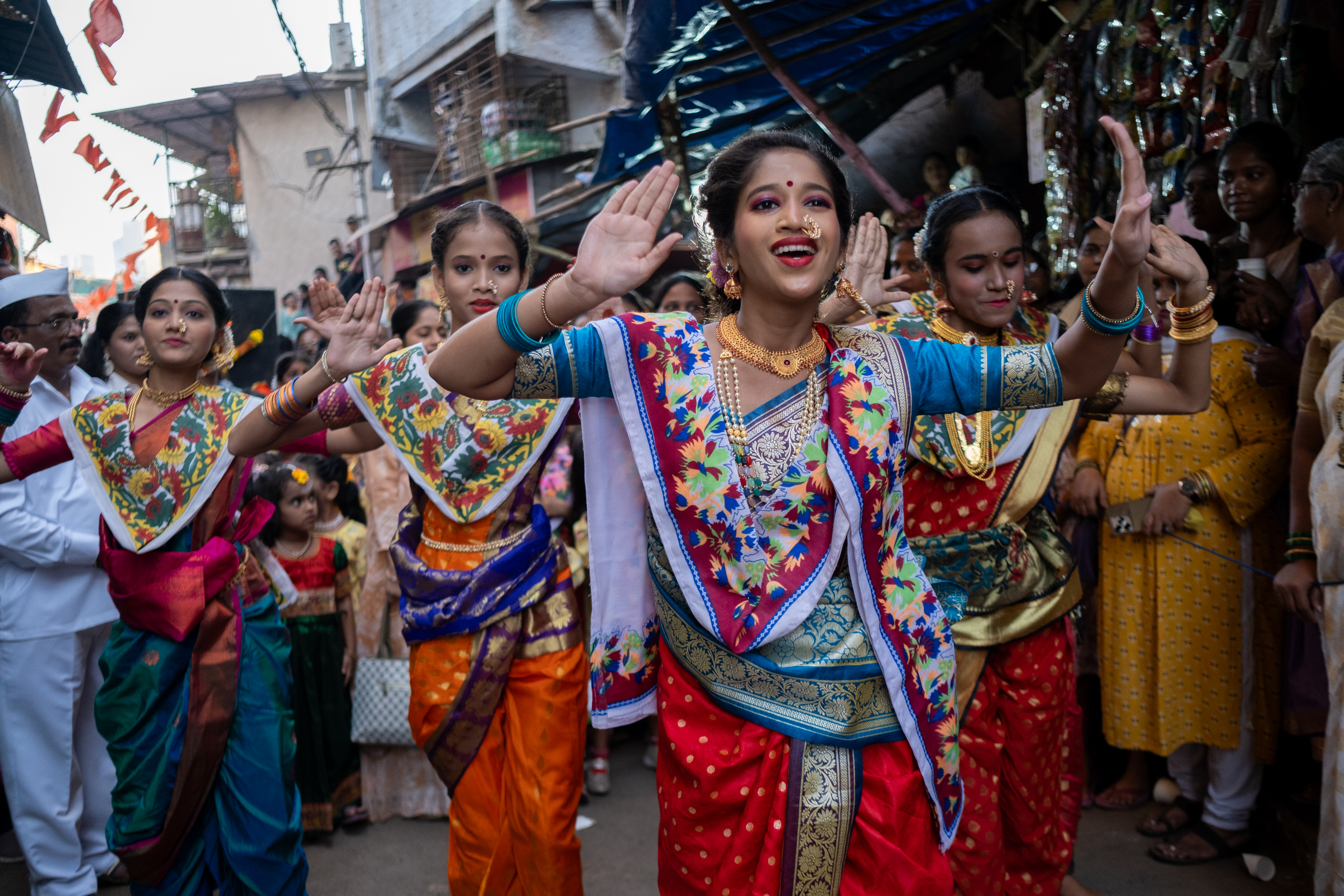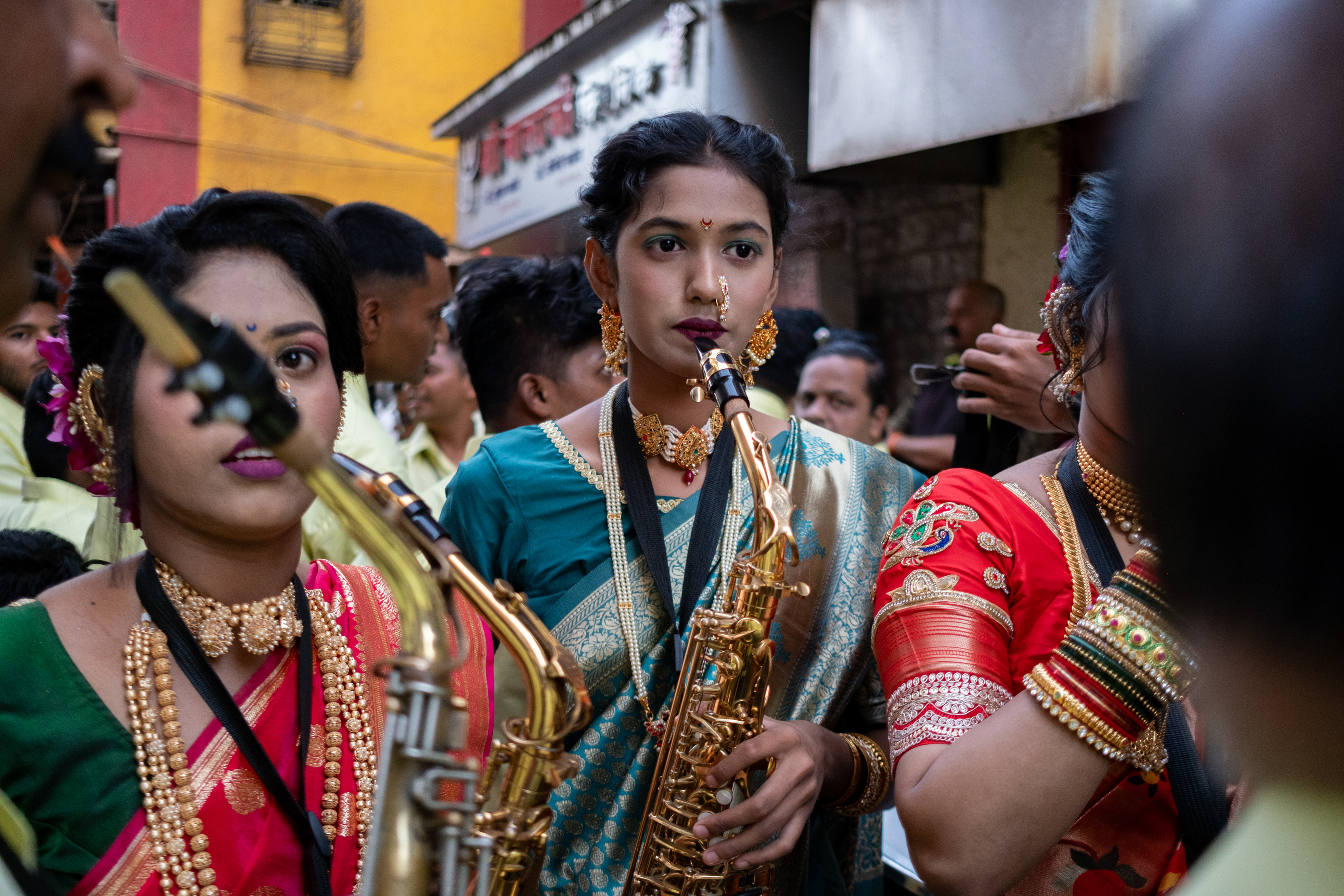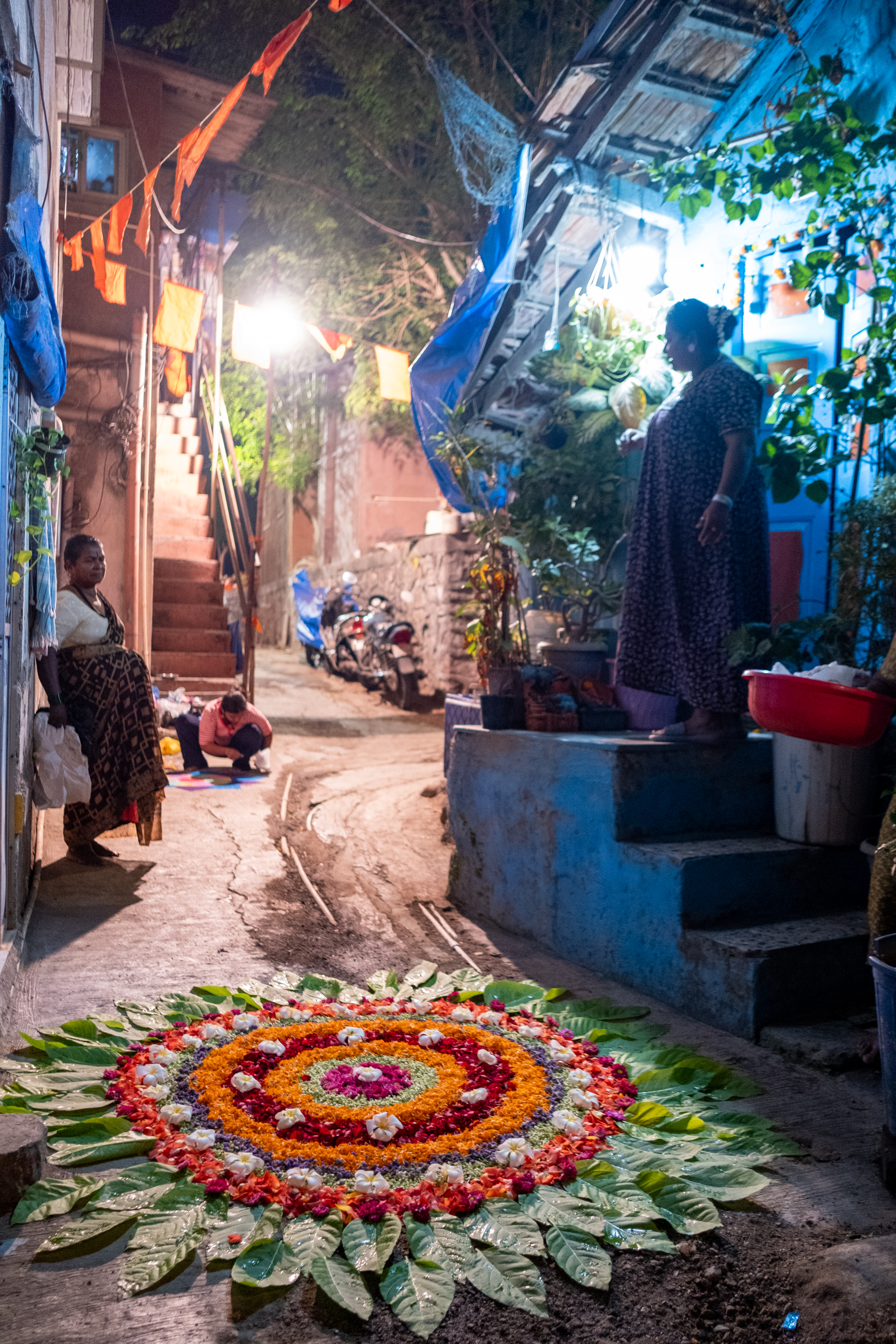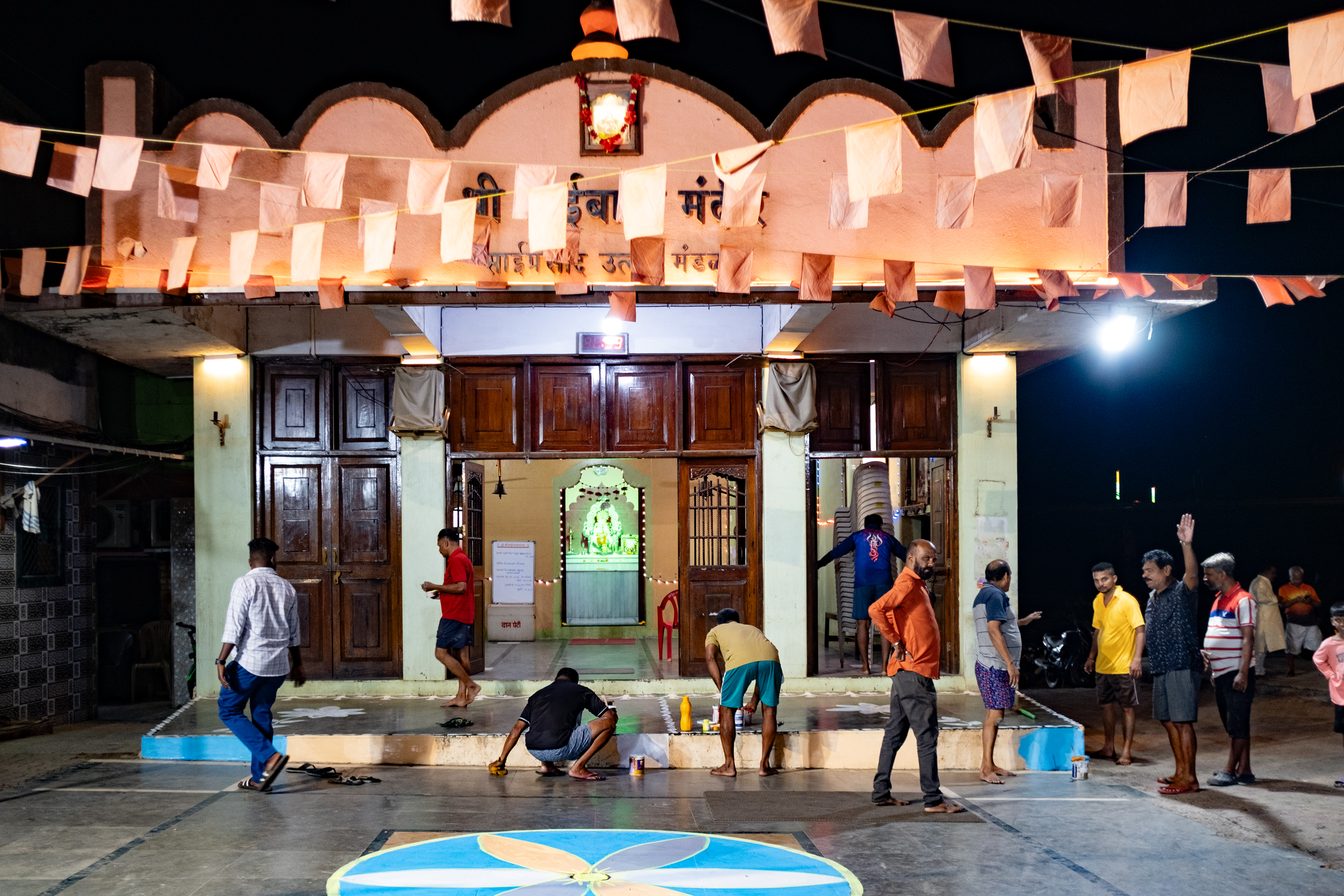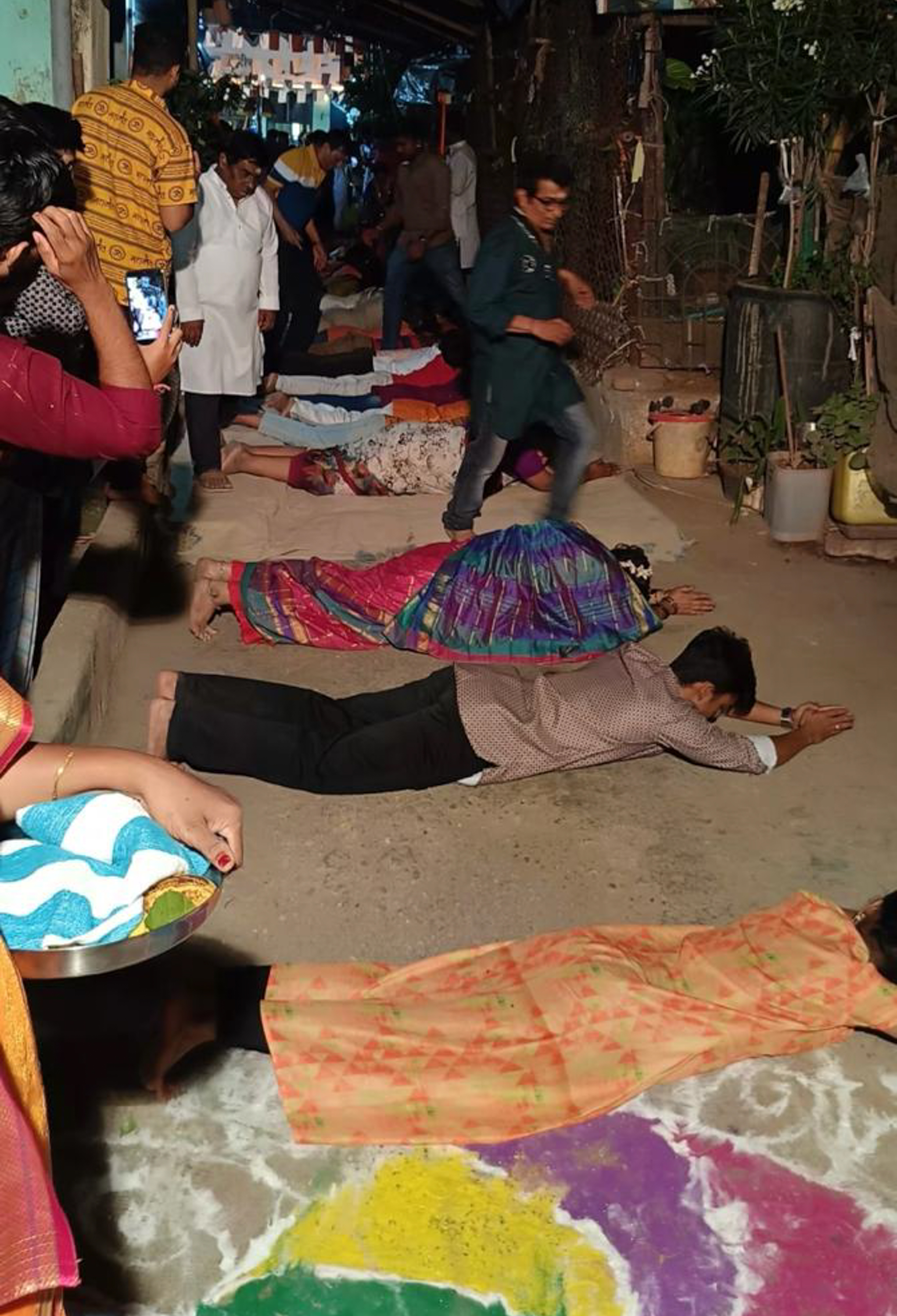The Union of Shiva and Shakti: Practices and Rituals of Maha Shivaratri
In 1904, the Papvimochneshwar Temple in Worli Koliwada came into existence. The temple is built in traditional Hindu temple architecture with a simple yet elegant design. The garbhagriha (sanctum sanctorum) is located at the heart of the temple, aligned with the main entrance and the temple's central axis. A shikhara rises above the garbhagriha, crowned with kalash (finial) and trishul (trident of Shiva). A covered mandapa serves as a congregational space for ritual performance in front of the garbhagriha. The temple compound houses stone deepastambhas and a tulsi (holy basil) planter.
Typical of Koli temples, the garbhagriha is built lower than the temple, with the lingam exposed on the floor. The lingam is a symbolic representation of Lord Shiva, who is regarded as formless. The lingam, along with the yoni (which represents Shakti, the divine feminine force), represents the union of Shiva and Shakti, the male and female principles and the source of all creation. The lingam at Papvimochneshwar is svayambhu, which refers to a self-manifest representation of Lord Shiva in the form of an aniconic lingam that appeared spontaneously without being carved or created by human intervention.
Papvimochneshwar Temple is a focal point for Maha Shivaratri celebrations, which fall on the 14th night of the new moon in the month of Phalguna, the 12th month of the Hindu calendar, which usually corresponds to February or March in the Gregorian calendar. Maha Shivaratri (the glorious night of Shiva) marks the union of Shiva and Parvati, the consort of Lord Shiva, who embodies Shakti. Their relationship symbolises the ideal marital bond and the balance of masculine and feminine energies in the universe. It is also believed that on this day, Lord Shiva performed the tandava, the dance of creation, preservation, and destruction, symbolising the cyclical nature of life, death, and rebirth.
Another story associated with Maha Shivaratri is the Samudra Manthan or the churning of the Kshira Sagara (Ocean of Milk). This story from Hindu mythology symbolically illustrates the cosmic struggle between good and evil and the quest for immortality. According to the Vishnu Purana, the devas (gods) and asuras (demi-gods) were in a constant state of conflict. After losing their strength and power due to a curse, the devas sought the advice of Lord Vishnu, who suggested churning the Kshira Sagara to obtain Amrita (nectar of immortality), which would restore their strength. The devas chose Mount Mandara as the churning rod. However, the mountain was too heavy to lift, so Vishnu took on the form of Kurma, the giant tortoise, to support it. Vasuki, the serpent king, served as the churning rope, coiling around Mount Mandara. The devas held the tail end, while the asuras held the head. The first substance to emerge from the churning was a deadly poison called Halahala, which threatened to destroy the universe. Lord Shiva consumed the poison to save the world and held it in his throat, which turned blue, earning him the name Neelkanth (the blue-throated one). Maha Shivaratri is believed to commemorate this event.
During Maha Shivaratri, people transform the svayambhu lingam into a mukhalingam by encasing it in a metal kavach (armour or casing) shaped like the head of Shiva. The word mukhalingam originates from the word mukha, which signifies "face," specifically the face of Lord Shiva. Devotees believe that the mukhalingam, with its anthropomorphic Shiva mukha, makes the divine more accessible, allowing for a deeper personal connection. The anthropomorphic face allows worshippers to engage in darshan (the act of seeing and being seen by the deity), enhancing their devotional experience.
Priests at the temple perform the abhishekam ritual, which involves the ceremonial bathing of the mukhalingam with sacred items, each poured while chanting specific mantras. These items include water, milk, yoghurt, honey, clarified butter, coconut water, and sandalwood paste. The ritual concludes with aarti (the waving of a flame, usually from a lit lamp, before a deity during prayers) and the distribution of prasad (blessed food). During Maha Shivaratri, devotees may perform abhishekam multiple times throughout the night, accompanied by different rituals and prayers at each session. This sacred ceremony is a highlight of the Maha Shivaratri, fostering a profound connection between devotees and the deity.
Devotees remove the mukhalingam from the garbhagriha and carry it on a palki (palanquin) after performing the abhishekam. The procession starts at the temple around five in the evening and makes its way through Worli village before returning early in the morning, around three. Residents of Worli Koliwada make rangoli along the procession route using chalk powder and flower petals. Dancers, devotional singers, and musical bands lead the procession. Along the way, the palki stops at households where married women perform the mukhalingam aarti. Devotees frequently stand in line for hours to participate in the mukhalingam's darshan.
Among other observances, fasting on Maha Shivaratri is a deeply significant spiritual practice for Hindus. Fasting is believed to purify the mind and body, removing toxins and negative energies. It shows the willingness to endure physical discomfort as a form of penance and reverence. Devotees observe different types of fasts, ranging from complete abstinence from food and water (nirjala vrat) to consuming only fruits and milk (phalahar vrat).
On the night of Maha Shivaratri, devotees engage in an all-night vigil (jagaran), reading or listening to stories from the Shiva Purana, which narrates Lord Shiva's exploits. Participating in devotional music during Maha Shivaratri strengthens the sense of community and shared faith among devotees. Devotees gather in the mandapa to chant hymns such as the Shiva Tandava Stotram and the Mahamrityunjaya Mantra, as well as perform kirtans and bhajans, accompanied by musical instruments such as the dhol, the kartal, the manjeera, and the tanpura.
Maha Shivaratri conveys a message of unity, emphasising that all creation is interconnected and that the divine presence pervades the entire universe. The rigorous spiritual practices during Maha Shivaratri are believed to purify the mind and body, absolve sins, and lead to spiritual liberation (moksha). Maha Shivaratri brings communities together through collective prayers, temple visits, and cultural programs, fostering a sense of unity and shared devotion. The festival's rich symbolism, religious observances, and cultural significance make it a vital part of the Hindu spiritual calendar.
The Koli community established the Papvimochneshwar Temple on August 18, 1904, dedicating it to Lord Shiva. The temple is the focal point of the Koli community's Maha Shivaratri celebrations, which take place annually on the 14th night of the dark fortnight in the month of Phalguna (February–March).
According to Hindu mythology, Maha Shivaratri marks the day when Lord Shiva performed the cosmic dance, Tandava, and the night he married Parvati. Maharashtra observes the festival with large gatherings in temples, fasting, and night-long vigils.
Flowers, fabrics, and other artistic elements elaborately decorate a silver palki (palanquin). This decoration is a form of cultural expression, showcasing local art and craftsmanship.
Nandi, the divine bull, is Lord Shiva's vahana (vehicle). Nandi serves as the gatekeeper to the sanctum, symbolising loyalty and unwavering devotion. The garbhagriha (sanctum sanctorum) places the marble Nandi statue directly facing the lingam.
Devotees engage in darshan (the act of seeing and being seen by the deity) of the lingam from outside the garbhagriha, through the door that allows a clear view. The temple sets the lingam, the primary focus of worship and rituals, on the floor of the garbhagriha, which is at a lower elevation than the temple.
A lady is holding a fly whisk (chowrie or chamara) with an ornate silver handle. Typically made from the tail hairs of a yak, the fly whisk is associated with royalty and divinity. In ancient times, attendants used it to fan kings, a symbol of respect and reverence.
Children apply bhasma (sacred ash) to their forehead, face, and arms. In Shaivism, bhasma (also known as vibhuti) reminds devotees of the transient nature of life, as it is a product of fire and symbolises the ultimate reality of death and the dissolution of the physical body.
A young girl whispers a wish into the ears of Nandi, the mount and messenger of Lord Shiva. To fulfill a wish, one must make it in secret by cupping one's hand over the ear and whispering so others may not hear.
A father teaches his child to ring a temple bell. Ringing the bell is considered a way to invite the deity and announce one's presence. The sound of the bell is believed to dispel negative energies and purify the environment.
The Koli community has a deep connection to the sea and marine life. The coconut holds significant cultural, religious, and economic importance in Koli culture. During Maha Shivaratri, the temple receives a special coconut, symbolizing royalty, shielded by an umbrella.
Priests at the temple perform the abhishekam ritual, which involves the ceremonial bathing of the mukhalingam with sacred items, each poured while chanting specific mantras. These items include water, milk, yoghurt, honey, clarified butter, coconut water, and sandalwood paste.
A niche in the garbhagriha houses goddess Parvati, the embodiment of Shakti, the divine feminine power. Maha Shivaratri is a celebration of the divine union of Shiva and Shakti. Their relationship symbolises the ideal marital bond and the balance of masculine and feminine energies in the universe.
The ringing of bells, the chanting of mantras, and the distribution of prasad (blessed food) among the devotees accompany aarti, the waving of a flame, usually from a lit lamp, before a deity during prayers.
Devotees wave their hands over the sacred fire and touch their foreheads as it passes around, symbolizing the reception of divine blessings. The aarti flame's light is believed to purify the mind and spirit, creating a sacred space for worship.
People worship Nandi alongside Shiva during Maha Shivaratri. The Nandi statue is bathed with milk, water, bael leaves, and other sacred items in a ritual similar to the abhishekam performed for the lingam.
During Maha Shivaratri, people transform the svayambhu lingam into a mukhalingam by encasing it in a metal kavach (armour or casing) shaped like the head of Shiva. The term mukhalingam originates from the word mukha, which signifies "face," specifically the face of Lord Shiva.
The lingam symbolizes Lord Shiva, a formless deity. Devotees believe that the mukhalingam, with its anthropomorphic mukha, makes the divine more accessible, allowing a deeper personal connection. The anthropomorphic face allows worshippers to engage in darshan, enhancing their devotional experience.
Vasuki, the coiled serpent (naga), has the mukhalingam attached to its body, forming a protective hooded canopy. The mythological story of Samudra Manthan uses Vasuki as the rope to churn the ocean of milk. Vasuki's presence symbolizes Shiva's mastery over fear and death.
The procession starts from the temple around five in the evening, takes a round of Worli Koliwada, and returns to the temple around three in the morning. The Koli children dressed up for the occasion and joined the procession.
Singers assemble to perform kirtans and bhajans, devotional songs that praise and glorify the divine, often recounting stories from Hindu mythology or expressing devotion and love for God. Bhakti traditions see kirtans as a powerful means to connect with the divine and experience a sense of oneness and unity with the universe.
Troupes of dancers perform in front of the temple as the procession prepares for departure. Cultural programs featuring music and dance are organised at regular intervals along the route of the procession.
Dressed in traditional sarees and jewellery, Koli dancers wait for their turn to perform and participate in the procession.
Koli men lift the palanquin onto their shoulders and carry it outside the temple premises. Devotees feel a closer connection to the deity when they participate in carrying the palanquin, which symbolizes the deity's presence among them.
Abhanga is a form of devotional music and poetry narrated throughout the procession. The term ‘abhanga’ literally means ‘unbroken’ or ‘indestructible,’ symbolising the eternal and continuous nature of devotion. They convey spiritual teachings, emphasising the importance of inner purity, detachment, and the pursuit of moksha (liberation).
Devotees stand in line for hours to witness the procession's darshan. The philosophical concept of Advaita (non-duality), which views the devotee and the divine as one, forms the basis of darshan. Darshan, therefore, is a realization of this oneness. It is believed that through darshan, devotees establish a direct connection with the divine, experiencing a sense of peace and spiritual fulfilment.
The all-night vigil includes the singing of devotional abhangas. Typically, writers write abhangas in quatrains (four-line stanzas) with a simple and rhythmic structure set to melodious tunes, making them easy to sing and remember. They are accompanied by traditional instruments such as the dhol, the kartal, the manjeera, and the tanpura.
A Koli woman carrying a container of holy water moves ahead of the procession and sprinkles water on the path using a genda phool (marigold flower). This practice represents the purification, sanctification, and blessing of the path to ensure the procession's smooth and auspicious progress.
Residents of Worli Koliwada draw rangoli on the procession route. Making rangoli is a communal activity that fosters a sense of togetherness and shared celebration among the participants.
Children participate in making rangoli designs.
Women wait in anticipation outside their homes, holding an aarti thali, to welcome the palki procession. The thali (plate) usually contains a diya (oil lamp), incense sticks, marigold flowers, and raw rice grains. During aarti, people ring a small bell to invoke the divine and ward off negative energies.
The palki stops in front of the household, where the women perform the mukhalingam aarti with a diya (lamp with wicks soaked in ghee or oil) or camphor, which burns without leaving a residue. The women apply tilak, a mark of blessing and protection, to the deity's forehead using kumkum (vermilion) and chandan (sandalwood paste).
Amidst the lively congregation on the street, music and dance performances unfold, adding to the festive atmosphere.
The palki's route encompasses temples, devotees' homes, and public spaces, symbolizing the dissemination of divine blessings throughout the community. The palanquin's movement through the streets symbolizes the deity's journey, blessing the areas and people it passes by. This journey is symbolic of the divine's omnipresence and its accessibility to devotees.
Being part of or witnessing a palki procession is considered spiritually uplifting. It symbolises the elevation of the human spirit by being in close proximity to the divine.
A troupe performs lezim, a Maharashtrian folk dance known for its energetic and rhythmic movements, including jumps, spins, and coordinated group formations. The lezim, a musical instrument of wooden or metal rods with small metallic discs attached, serves as the inspiration for the dance's name. When shaken, the discs produce rhythmic jingling sounds.
The Nauvari saree, also known as the Kashta saree, is a traditional Maharashtrian attire worn by Koli women. The Nauvari saree is a nine-yard saree, as opposed to the regular six-yard saree. Women involved in the fishing business find the Nauvari saree practical due to its specific drape, which allows for greater movement.
While the saxophone is not traditionally a part of Koli music, its use in fusion styles demonstrates the adaptability and evolution of traditional musical forms. Incorporating Western instruments like the saxophone adds a new dimension to Koli music, creating a unique and dynamic sound that appeals to a wider audience.
A floral rangoli made from marigolds, roses, frangipani, and jasmine. Worli Koliwada, like many other old neighbourhoods in Mumbai, is characterised by narrow, winding lanes and closely packed houses. Despite the narrowness, these lanes serve as common spaces where residents come together to decorate during festivals.
The Sai Baba Temple, located near Worli Fort, is the culmination of the procession. The open space in front of the temple is ideal for large gatherings. After a brief halt at the Sai Baba Temple, the procession starts the return journey to Papvimochneshwar Temple.
As the procession makes its return journey, devotees perform a ritual called lotangan. Lotangan is a term in Marathi that refers to the act of prostration or bowing down in reverence. It is a gesture of respect and devotion, commonly performed in front of deities, elders, or revered individuals.
